
Find anything, super fast.
- Destinations
- Documentaries


How Artificial Intelligence Could Transform the Yachting Industry
By Frances Flannagan
Artificial Intelligence (AI) is undeniably becoming more prominent in our everyday lives. Its development has now reached the superyacht industry, with IYC being the first company to introduce AI to yacht management.
Whether you fear it or are for it, there is no denying the fact that Artificial Intelligence (AI) is creating endless possibilities within the world that we live in. This limitless potential extends to the yachting industry, an industry known for its luxurious nature and its place amongst society’s elite. From trip planning to fuel calculations, AI has the potential to completely reshape the industry, moving us into the future of yachting.
What was once mere speculation has become a reality: IYC is the first company to introduce AI to yacht management. They have created a software named BLUE which seamlessly ties all yacht management operations together, streamlining life onboard. It is a market-leading yacht support software system exclusive to IYC, having already proved popular with owners and crew as it is straight-forward to use, increases efficiency and ensures compliance.
Anna is BLUE’s AI Yacht Manager; she handles administrative tasks and compliance requirements whilst guiding crew, owners and managers. She operates as a ‘virtual yacht manager’ ensuring increased safety on board.
Celine Robins, the Global Yacht Management Director of IYC, has commented on the significance of BLUE: ' This is the first time in the world that artificial intelligence is brought into the yachting industry and to yacht management. That is extremely revolutionary. Artificial intelligence is going to reshape our world.'
In a recent announcement, Robins proceeded to provide insights into the significance of BLUE not only for the industry, but for IYC and for clients. She recognised the reduction of costs as well as no more human errors, both benefits for IYC. She believes that more focused work due to the simplicity of the software will result in increased consumer satisfaction, ensuring repeat clients for the vessels.
The benefits for the owner are also cost-related; the preventative maintenance provided by BLUE will save the owner a lot of money as yacht checks and services will be carried out regularly and on time.
The future is undeniably bright with BLUE; as the software grows and AI becomes more prominent in our everyday lives, there is limitless potential and endless possibilities for virtual solutions.
"This is the first time in the world that artificial intelligence is brought into the yachting industry and to yacht management. That is extremely revolutionary. Artificial intelligence is going to reshape our world." Celine Robins, Global Yacht Management Director, IYC
"This is the first time in the world that artificial intelligence is brought into the yachting industry and to yacht management. That is extremely revolutionary. Artificial intelligence is going to reshape our world."
Related News
Featured events.

How AI is Transforming the Superyacht and Business Aviation Industries

For two industries that have much in common, the difference in the adoption of artificial intelligence on private jets versus AI integration on superyachts is stark. While the aviation industry has been using artificial intelligence in its engines for almost 25-30 years now, the superyacht industry is yet to get started.
So, why the disparity between AI usage on large yachts and private planes? After all, the target market for both is similar, with many ultra high net worth individuals (UHNWIs) owning one (or more) of each asset. If the owners and users of business jets are expecting the best and latest technology for their plane, then why aren`t they asking for the same from their superyacht?
To answer this, it's helpful to have some context. “When you analyse the trends you realise how far the aviation industry is ahead of everybody,” points out Joseph Adir, founder & CEO at WinTech Marine Intelligence. Moderating the AI panel at Quaynote's online conference, The Future for Superyachts, Business Jets and Luxury Property, Adir holds up companies like Netjets and JetEdge whose business models are both heavily reliant on AI. “Netjets currently operate 750 planes that have no set flight schedule from one day to the next. They are all shared owners and decide at the last moment where they want to go.”
Where AI comes in is in making sense of this logistical headache. “Algorithms created by Netjets ensure that planes are where they should be, meeting the needs of clients and all in a cost-efficient way,” he explains.

For Joseph Adir, whose company Wintech Marine Technology is creating a predictive maintenance system for superyachts, the benefits of AI go hand-in-hand with sustainability. “There is nothing better than AI to improve your performance, reduce fuel consumption, costs and expenses,” he states. “And yet we still build and design yachts the same way it was done 20 years ago.” Given the increasing awareness by yachts and jet owners alike of sustainability issues, the apparent reluctance in the superyacht industry to embrace AI technologies is perplexing.
With so many compelling reasons for the superyacht industry to follow aviation`s lead, Dominic Bulfin, director at Bargate Murray, threw some light on the differences lying at the heart of this discussion. “One difference is that business jets are largely a tool,” he observes. “The jet is not a luxury in itself and I think that`s an important factor in why there's been a delay in yachts adopting technology.” He wonders if yacht builders should be steering owners towards incorporating AI in their newbuilds, educating them about the potential savings, additional safety, etc., that can be gained without compromising on the beauty of the vessel.

Contrast this with the degree of tech awareness in the private aviation space, where synthetic vision is more-or-less standard in all the leading planes, and a picture starts to emerge. “For OEMs, AI/tech is something they talk about in every sale. They're always trying to out-tech the next guy,” asserts Jeff Lowe.
But is this really a critical factor for the client? “The guy at the back, he's into the design of the cabin and everything else, but he still has an ear for the safety, the systems, the maintenance. What makes for him is the availability, making sure that his plane is available more often than not. So yes, he is interested.”
While both jet and yacht owners expect their asset to be readily available, there is arguably a more personalised aspect to the superyacht business. The customisation of the superyacht itself is a key factor that separates it from the business jet. “Planes are fairly homogenous, whereas each and every superyacht is different from the next. A Boeing 737 is a Boeing 737,” says Joseph Adir. “But, on a yacht the engine, navigation systems – everything – is different and this is the challenge for us.” This high level of differentiation creates the need for a very advanced AI platform, which brings its own set of obstacles for the superyacht industry.

So, if properly handled, there appears to be no reason why the superyacht industry cannot enjoy the same AI successes that business aviation has been able to reap for the last two decades. But who will drive this evolution? Will it be the owners, builders or regulators who will push for change?
Drawing on his own experience in the private jet sphere, Jeff Lowe is clear. “I'd love to say that the OEMs are the single source, but the regulators are constantly pushing the industry to make sure they have the best of the best,” he notes. With regulations less stringent in the superyacht industry than for our aviation counterparts, Joseph Adir thinks it is down to yacht builders to drive the change. “There is no way to educate 7,000 owners one by one,” he reasons.
The good news is that exciting developments are already in the pipeline. The commercial shipping industry reported to be two or three years away from launching the autonomous container ship. Moreover, a fully autonomous yacht, the product of a joint venture between a start-up venture and IBM, is set to sail at some point in the future between the UK and New York. The possibilities for superyacht AI look poised to become reality.

Post your comment
You cannot post comments until you have logged in.
No one has commented on this page yet.
RSS feed for comments on this page | RSS feed for all comments
Search articles with keywords

Rossinavi Oneiric
Yachting’s intelligent change
The focus of technology applied to yachts often centres on power and propulsion systems, but pioneering designers and projects are applying it in other ways – from ensuring inclusion to embracing the possibilities of AI.
Since the dawn of Western thought, and likely long before, the idea of technology has engendered various questions – the philosophy of technology, if you will. Such questions, which consider the nature of technology and its social effects, seem at the forefront of our collective consciousness now more than ever. We talk about the impact of technology on our environment and climate, and the role that technology can have in reversing that impact; or the implications of advancing machine learning and the rise of artificial intelligence, and whether those represent an opportunity or a danger to our society.
In ancient Greek philosophy, technology – which derives from the Greek word techne (meaning art, or craft knowledge) – was commonly viewed as arising from an imitation of nature. Our general understanding of technology these days often seems at odds with the natural world, but increasingly things are coming full circle. That is particularly true, I would suggest, in the superyacht sector.
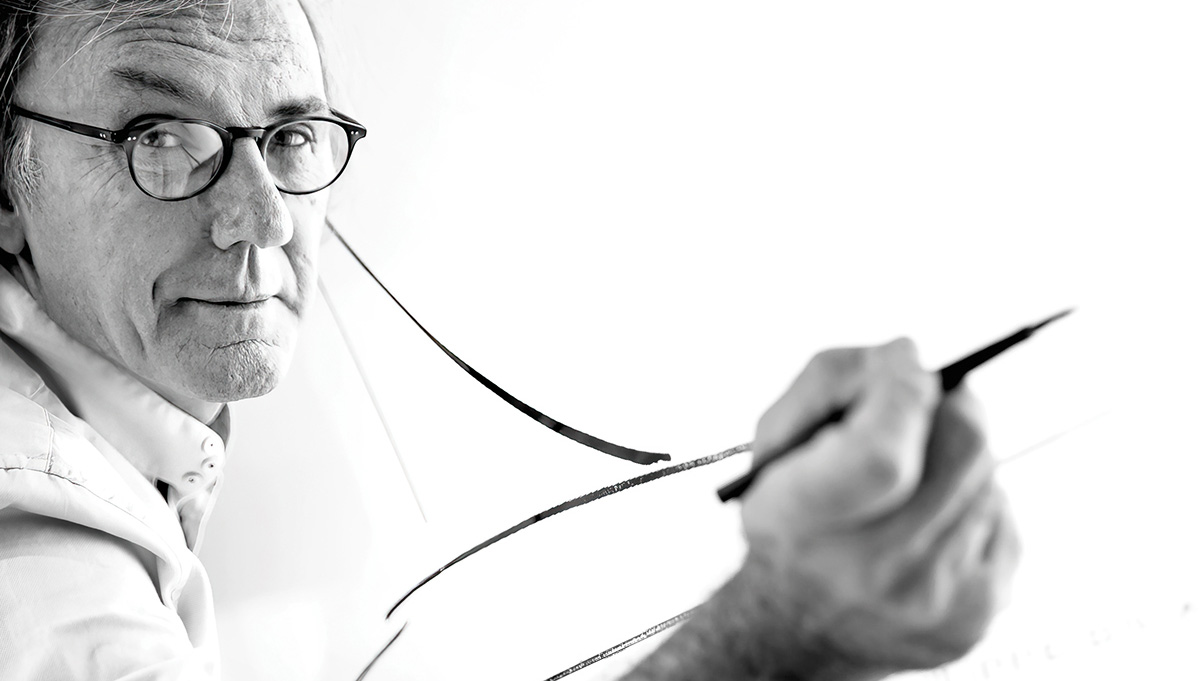
Philippe Briand Photo: Gullaume Plisson
We often talk about superyachting being a crucible of technological development, and it is true that, out of all maritime sectors, yachting has the least commercial pressure to stick to the status quo and the most to gain by seeking new and advanced solutions to the problems of emissions, sustainability and environmental impact. That the superyacht sector is not only drawing on but in many ways leading the charge to a zero-emission and a net-zero future is amply demonstrated by various projects in build that are employing not only diesel-electric solutions, but actively incorporating hydrogen-based power and propulsion systems to mitigate or remove the need for harmful fossil fuels.
But the application of technology means so much more these days than just an approach to systems or propulsion. Unveiled early in 2023, a shortlisted design from Team FestivAL – which combines the talents of Philippe Briand’s Vitruvius Yachts naval architecture office, Zaha Hadid Architects, and aluminium boat specialist Ocea – for a National Flagship for the UK (a replacement for the old yacht Britannia ) draws on a hydrogen-based propulsion system. But this ‘yacht of the people, but fit for a king’ project is also designed to maximise accessibility for people of all ages and all levels of ability or disability. It would feature wall-to-wall displays showing presentations adaptable to the yacht’s given role at the time, and a multi-sensorial experience throughout the yacht that would include sign language and audio descriptions. There is even a modular mission bay aft that can be used for carrying humanitarian supplies or serving as a modular science lab. This is technology with a social philosophy, combined in what essentially is a private yacht open to the masses.
“To design a vessel – a flagship – that will become a benchmark in sustainability as well as demonstrating British excellence and heritage for current and future generations, while also being a symbol of inclusion and diversity, was an enormous challenge that kept me awake at night,” says Philippe Briand. “The nature and intensity of the project kept me focused but also filled me with pride, not just in the design process itself but for what the flagship stands for.”

That’s not the only example of the changing role technology is taking in new yacht projects. When it comes to artificial intelligence – about which the philosophical and technological debate is currently raging – in many ways yachts already bear its evolution as sensors on every element of equipment and system start to analyse status and progression to provide predictive maintenance. For Italian superyacht builder Rossinavi , however, AI forms a far more fundamental element of its yacht philosophy. It is emerging in what the shipyard has called BluE – an eco-centric navigation technology and AI engine.
It has been incorporated in Rossinavi concepts such as the Infinty 42 BluE monohull, the 40-metre Sea Cat motor catamaran, and other designs, and is already being realised with the first Sea Cat under construction, among other projects. This new breed of vessel of course draws on green energy solutions – in the Sea Cat’s case using solar energy to supply a battery bank which means the yacht can operate in full electric mode for cruising and anchoring. It can achieve a transatlantic crossing under electric power alone for 80 percent of the time, with a diesel-electric hybrid system on just 20 percent of the time – a fact, says Rossinavi, that saves 40 tonnes of CO2 on a single crossing compared to a conventional yacht. It can even serve as a giant powerbank when in ‘hybernation’ mode, delivering green power into the shorebased grid or to a private residence.
But it’s the AI element that is really interesting. The system creates an ‘intelligent vessel’ which monitors shipboard habits and suggests behaviours to further save energy. It also adds an infotainment element via a voice-controlled Smart assistant that provides information on places of interest, trivia and local activities. The whole is linked to Rossinavi’s underlying philosophy that takes inspiration from phytoplankton, the essential microbial lifeforce that draws energy from the sun, traps carbon dioxide, and underpins the health of the entire ocean. Techne , or an imitation of nature, indeed.
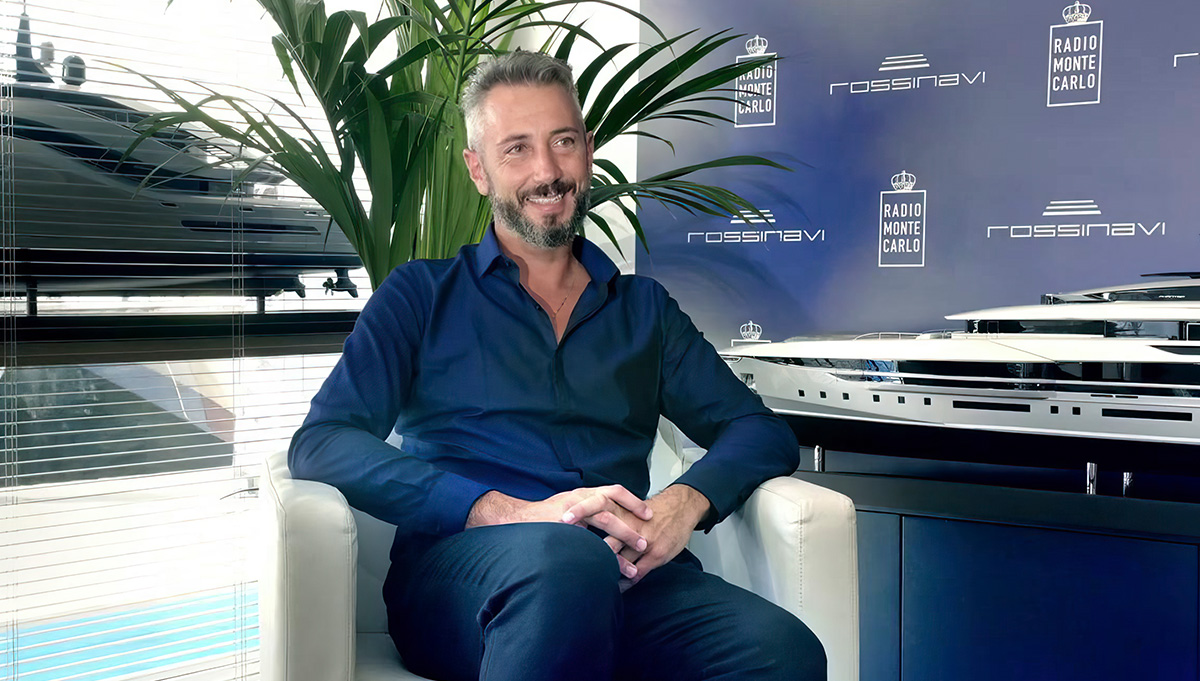
Federico Rossi
“The idea is to create a link between nature, electricity and futurism, which, supported by the most advanced technologies, is able to offer excellent performance to the Sea Cat 40 that offers priority to the environment,” says Federico Rossi, Chief Operating Officer of Rossinavi. “[The] new generation of yachts is moved by a sense of responsibility,” he continues. “I wanted to set the goal beyond the obstacle to build avant garde products that better express our meaning of cruising experience, moving increasingly toward a more sustainable direction.”
For Rossi, it is not just the responsibility of superyacht owners and the world’s ultra high net worth individuals to, essentially, clean up their act, but also to remember that in modern society their actions and their decisions can have a real impact on society at large. It’s why the superyacht industry in general, it could be argued, is making such great strides forward, because we know collectively both the negative effects if we don’t, and the positive impacts if we do.
“In the world of influencers, the wealthy and the billionaires give the common citizen a kind of ideal aspiration, which needs to go beyond the image of an extremely high performance car totally heedless of the CO2 emissions it entails, otherwise we risk giving the new generations that kind of ambition,” Rossi has said. “If these influencers manage to change this approach, we can really improve the world.”
You may also like...

Rewarding lives in superyachting
A superyacht may be near the pinnacle of experiences, but there is more to superyachting than just luxury and glamour. From philanthropy to humanitarian endeavour, people remain central, as the inaugural Honours seeks to highlight.

Seeking healthier waters in Menorca and beyond
Sunseeker and Blue Marine join forces for Project Menorca, aimed at protecting the seas around this popular Balearic island.
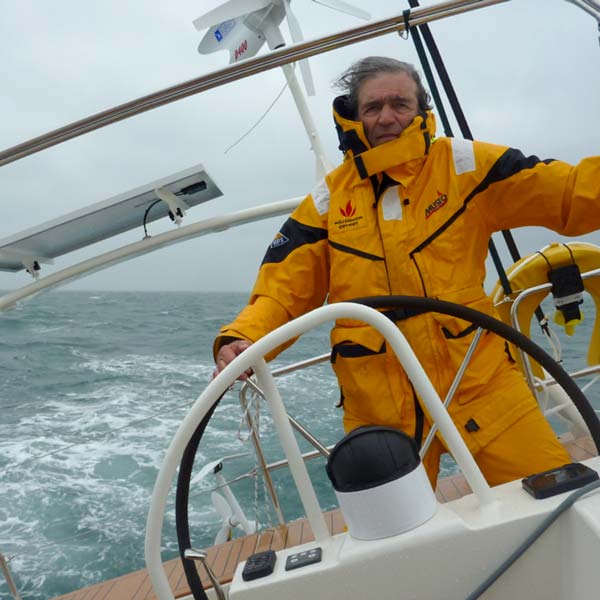
Jimmy Cornell
The Romanian-born yachtsman, author and founder of the World Cruising Club recalls six special years spent at sea with his wife and two children.
Do you work in the superyacht industry? Yes No I would like to receive updates from Superyacht Life
Don’t miss out
Sign up to our newsletter and get our latest stories delivered monthly to your inbox.
Please use a modern browser to view this website. Some elements might not work as expected when using Internet Explorer.
- Landing Page
- Luxury Yacht Vacation Types
- Corporate Yacht Charter
- Tailor Made Vacations
- Luxury Exploration Vacations
- View All 3565
- Motor Yachts
- Sailing Yachts
- Classic Yachts
- Catamaran Yachts
- Filter By Destination
- More Filters
- Latest Reviews
- Charter Special Offers
- Destination Guides
- Inspiration & Features
- Mediterranean Charter Yachts
- France Charter Yachts
- Italy Charter Yachts
- Croatia Charter Yachts
- Greece Charter Yachts
- Turkey Charter Yachts
- Bahamas Charter Yachts
- Caribbean Charter Yachts
- Australia Charter Yachts
- Thailand Charter Yachts
- Dubai Charter Yachts
- Destination News
- New To Fleet
- Charter Fleet Updates
- Special Offers
- Industry News
- Yacht Shows
- Corporate Charter
- Finding a Yacht Broker
- Charter Preferences
- Questions & Answers
- Add my yacht
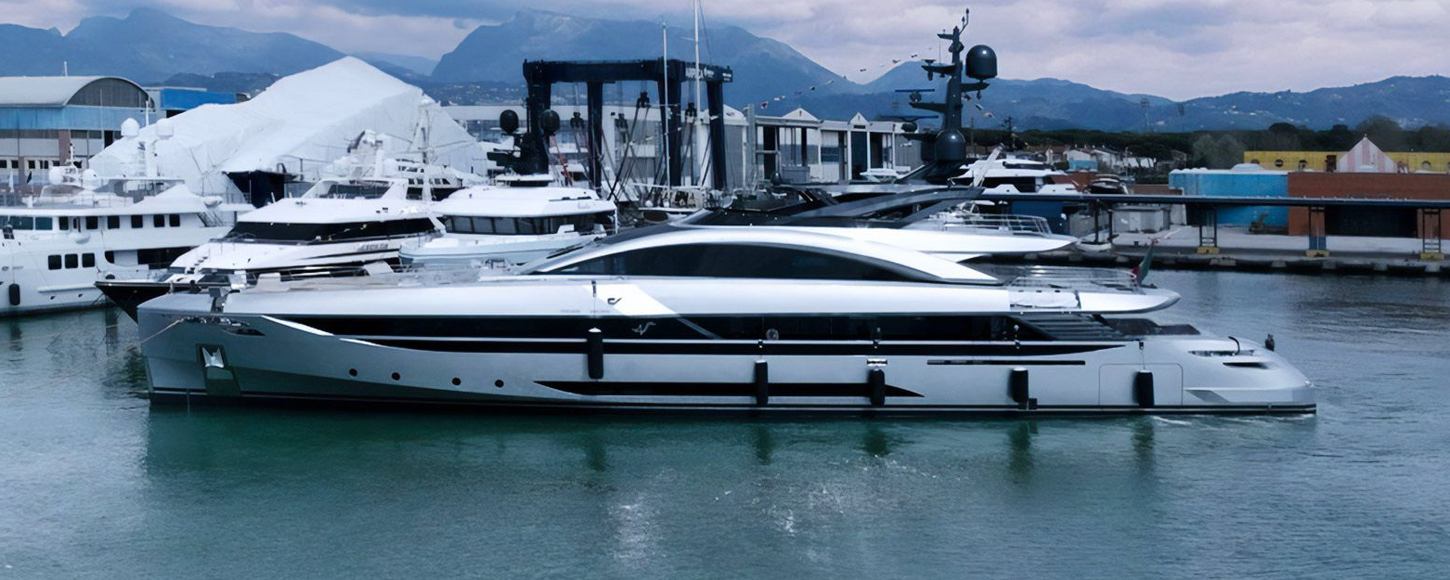
- Yacht Charter Fleet
Introducing the NO STRESS TWO: A Revolutionary Hybrid Yacht with Artificial Intelligence
- Share this on Facebook
- Share this on X
- Share via Email
By Anna Ingles 8 September 2023
Get ready to embark on a new era of luxury cruising with the launch of NO STRESS TWO . This groundbreaking 50m Rossinavi hybrid yacht, designed by the renowned Enrico Gobbi, is set to revolutionize the industry with its cutting-edge features, including Artificial Intelligence integration.
Unveiled in April 2023, NO STRESS TWO is not your ordinary yacht. With its intelligent hybrid propulsion system, this stunning motor yacht offers five operation modes, dual power systems, and a fast displacement aluminum hull. But what truly sets NO STRESS TWO apart is its integration of Artificial Intelligence, which optimizes electric mode efficiency to provide an unparalleled cruising experience.
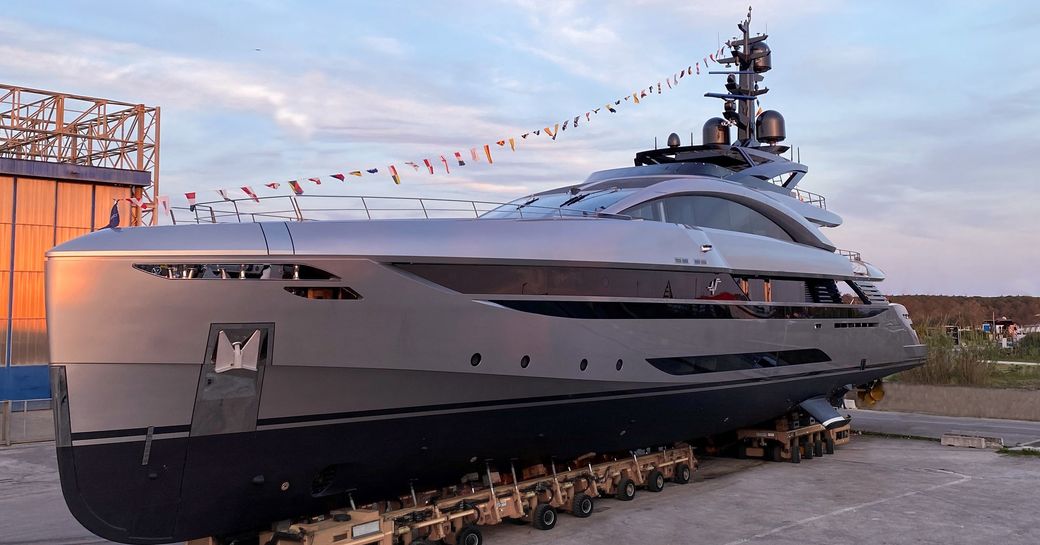
Federico Rossi, the Chief Operating Officer of Rossinavi, explains, "'No Stress Two is a hybrid vessel characterized by a strong sporty attitude. It is a high-performance superyacht with dual fuel: diesel and battery. Artificial Intelligence allows you to enjoy the electric experience on board to the fullest." And this is just the beginning, as Rossinavi plans to unveil even more advanced technology with the launch of the Sea Cat next year.
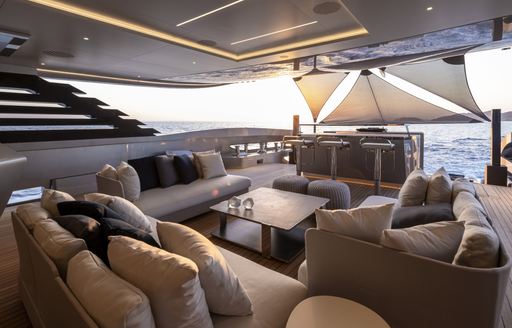
Beyond its groundbreaking technology, NO STRESS TWO boasts exceptional design features. A meticulous attention to detail has been employed in the study of space, evident in the comfortable walking area surrounding the 10 sqm pool in the bow. The open Beach Club, a standout highlight for the superyacht, includes a DJ station with a screen overlooking the area on the aft cockpit, providing the perfect setting for luxurious parties in the Mediterranean .
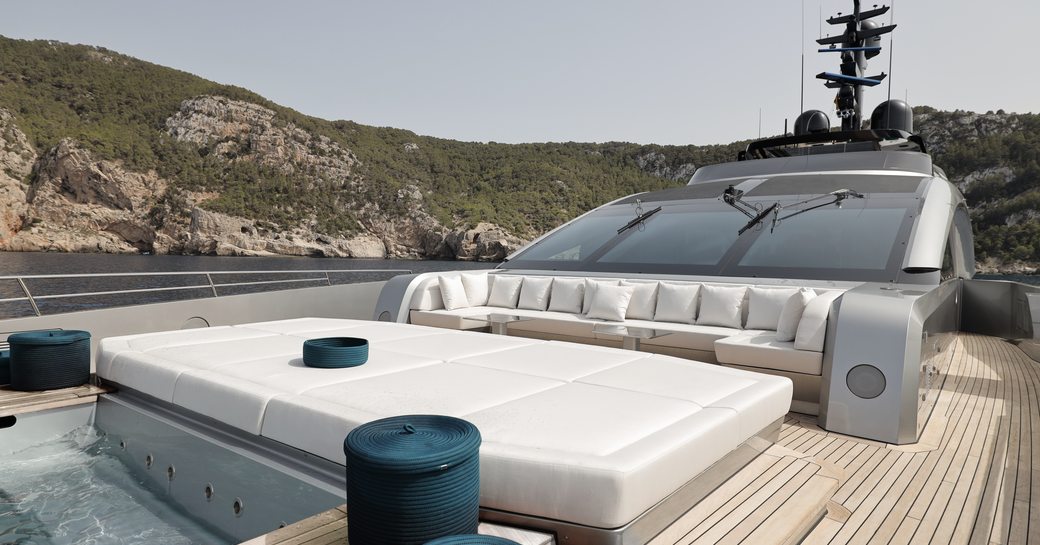
Stepping inside you'll be captivated by the elegant interiors. With a combination of refined details, precise alignments, and the use of natural and prestigious materials, the result is a sophisticated ambiance and an environment that emphasizes the indulgence of the superyacht lifestyle. Enrico Gobbi, the mastermind behind the interior design, explains, "The study of the hull openings and the superstructure was fundamental, to have a yacht with sporty lines without compromises, giving the interiors the maximum landscape view."

NO STRESS TWO marks an exciting turning point for the superyacht industry. With its innovative hybrid propulsion system and state-of-the-art design, this vessel represents a new way of navigating and experiencing the sea. As we sail towards a more sustainable future, NO STRESS TWO paves the way for a new generation of luxury yachts that prioritize both performance and environmental consciousness.
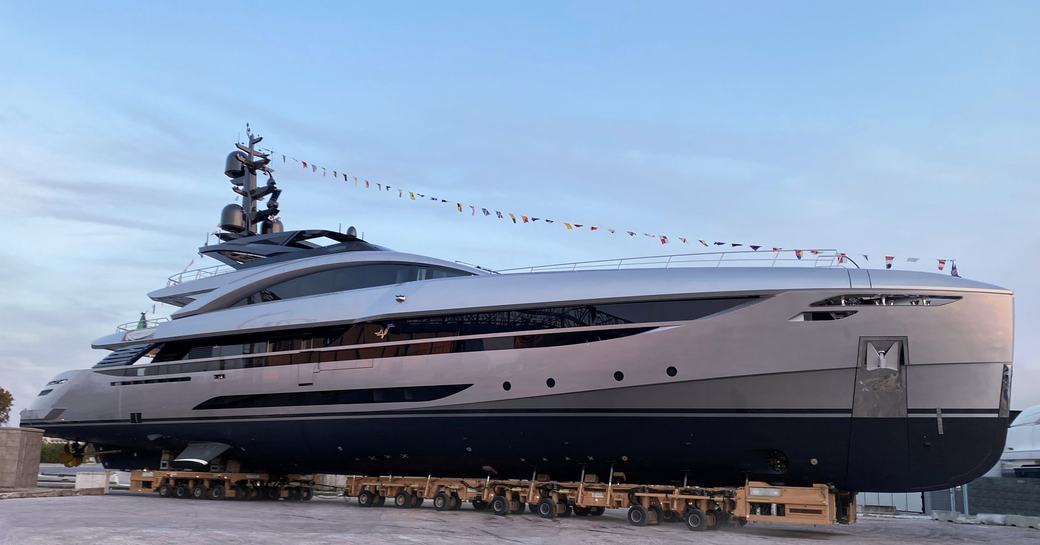
NO STRESS TWO is not currently available for charter, however, if you'd like to charter a yacht of a similar caliber take a look at all available crewed yacht charters .
Alternatively, speak to your preferred yacht charter broker today for more details on Rossinavi charter yachts .
Rossinavi charter yachts

48m Rossinavi 2014 / 2023
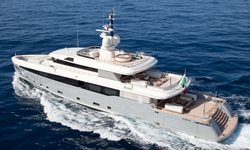
48m Rossinavi 2012 / 2022

39m Rossinavi 2015
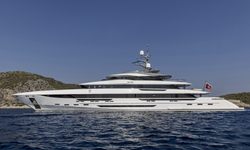
70m Rossinavi 2021
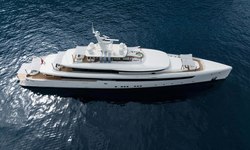
66m Rossinavi 2023

63m Rossinavi 2018
- READ MORE ABOUT:
- NO STRESS TWO
RELATED STORIES
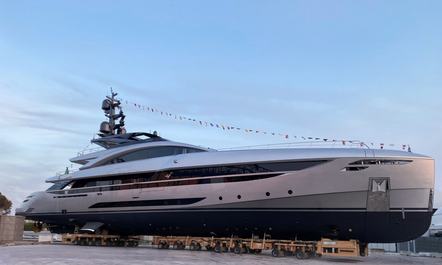
Previous Post
CRN ANNOUNCES 70m Project Thunderball
Motor yacht AIFER opens bookings for France yacht charters
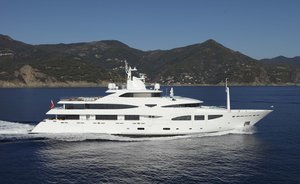
EDITOR'S PICK
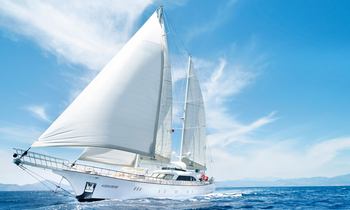
Latest News
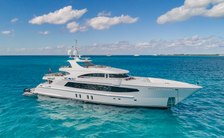
15 March 2024

14 March 2024

13 March 2024
- See All News
Yacht Reviews
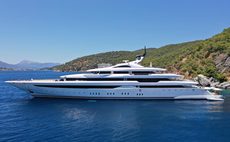
- See All Reviews

Charter Yacht of the week
Join our newsletter
Useful yacht charter news, latest yachts and expert advice, sent out every fortnight.
Please enter a valid e-mail
Thanks for subscribing
Featured Luxury Yachts for Charter
This is a small selection of the global luxury yacht charter fleet, with 3565 motor yachts, sail yachts, explorer yachts and catamarans to choose from including superyachts and megayachts, the world is your oyster. Why search for your ideal yacht charter vacation anywhere else?

136m | Lurssen
from $4,376,000 p/week ♦︎
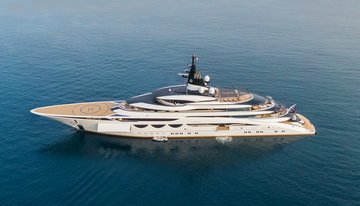
115m | Lurssen
from $2,844,000 p/week ♦︎
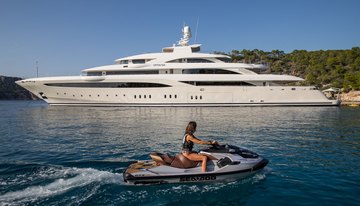
85m | Golden Yachts
from $985,000 p/week ♦︎
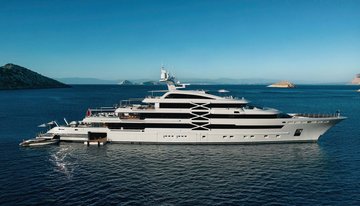
88m | Golden Yachts
from $1,203,000 p/week ♦︎
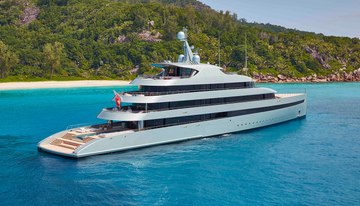
84m | Feadship
from $1,094,000 p/week ♦︎

93m | Feadship
from $1,532,000 p/week ♦︎

Maltese Falcon
88m | Perini Navi
from $490,000 p/week
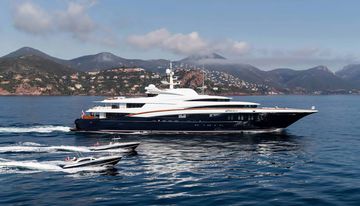
76m | Oceanco
from $860,000 p/week ♦︎
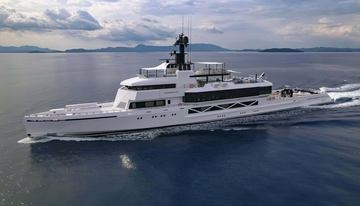
85m | SilverYachts
from $960,000 p/week
As Featured In
The YachtCharterFleet Difference
YachtCharterFleet makes it easy to find the yacht charter vacation that is right for you. We combine thousands of yacht listings with local destination information, sample itineraries and experiences to deliver the world's most comprehensive yacht charter website.
San Francisco
- Like us on Facebook
- Follow us on Twitter
- Follow us on Instagram
- Find us on LinkedIn
- Add My Yacht
- Affiliates & Partners
Popular Destinations & Events
- St Tropez Yacht Charter
- Monaco Yacht Charter
- St Barts Yacht Charter
- Greece Yacht Charter
- Mykonos Yacht Charter
- Caribbean Yacht Charter
Featured Charter Yachts
- Maltese Falcon Yacht Charter
- Wheels Yacht Charter
- Victorious Yacht Charter
- Andrea Yacht Charter
- Titania Yacht Charter
- Ahpo Yacht Charter
Receive our latest offers, trends and stories direct to your inbox.
Please enter a valid e-mail.
Thanks for subscribing.
Search for Yachts, Destinations, Events, News... everything related to Luxury Yachts for Charter.
Yachts in your shortlist

- Subscribe Now
- Digital Editions

OSCAR first look: The revolutionary system bringing AI to yacht navigation
- Top stories
A new type of navigation equipment that combines artificial intelligence with both thermal and low light cameras promises to make offshore cruising a safer, more relaxing experience.
Aesop’s fable about the tortoise and the hare still rings true at sea as owners of displacement-only trawler yachts will be only too happy to tell you.
When transiting on a lengthy passage from somewhere like the UK to the Med at the same time as a much faster planing yacht, they will often watching the faster boat speed off into the distance only to see it slope into Gibraltar several days after they’ve arrived.
That’s because while the planing boat has been coast-hopping from port to port, spending the nights in marinas, the trawler yacht has been plodding along day and night without even stopping for fuel.
Article continues below…
Raymarine ClearCruise brings augmented reality to boating tech
Best boating gadgets: 6 of the best options for upgrading your boat’s tech, recommended videos for you.
It’s a salutary lesson in slow and steady winning the race but it comes at a cost – the need for someone to stay on watch all through the night with a rota to allow everyone to get some sleep.
But what if you could leave the graveyard shift to a robot watchkeeper with eyes that can see in the dark and an artificial brain that can recognise potential threats long before the human eye could even spot them and one day even steer around them?
That is the longterm premise behind OSCAR, an entirely new type of navigation equipment that aims to bring artificial intelligence and autonomous learning to the world of boat navigation.

By checking the information from both cameras against a constantly updating database as well as the object’s range and position it can assess whether it poses a collision risk, alert the skipper to the danger and, where possible, identify what the object is
Currently sold as a watchkeeping aid (it can’t yet legally replace a human) it should nevertheless make night cruising a lot safer and more relaxing.
That’s because it continuously scans the water in front of the boat, looking for potential hazards which may be invisible to radar and AIS , identifying what they are and alerting the skipper to their presence.
The key to this ability is a combination of thermal imaging cameras and low light/daylight cameras which can pick up obstacles with very low radar profiles such as lobster pots, tree trunks, whales and semi-submerged containers as well as more obvious hazards like ships, icebergs and reefs.
Heat sensitive
The reason it’s able to do this is due to the sensitivity of the infra-red camera, which can detect temperature differences as small as 0.09 deg F.
Thanks to the differing thermal characteristics of materials like wood, metal and plastic, and the difference in the ambient temperature of the sea and air, it can pick up inanimate floating objects with remarkable clarity.
And of course anything that creates its own heat such as cetaceans, ships and people, show up like beacons against, making it an invaluable extra safety tool in locating MOBs, especially at night.
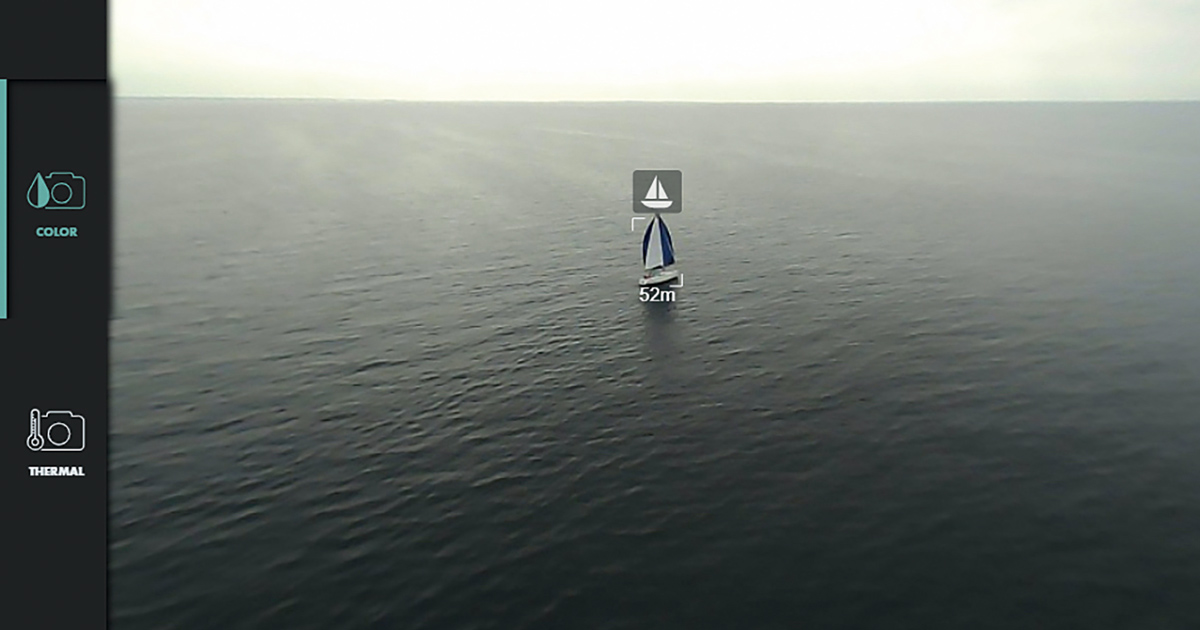
The daylight camera view
When combined with a conventional low light camera and a 16 X electronic zoom, it forms a very clear picture of the potential hazard.
The really clever bit is that it can then check the visual and thermal characteristics of the object against a vast database of similar sightings accumulated over more than 300,000 nautical miles of other OSCAR users’ voyages to help identify and assess the danger.
At the same time as alerting the skipper of anything that poses a potential collision risk, it is also constantly updating the database.

Thermal camera can pick things up in total darkness
The result is an ever-growing network of information that will refine and improve the system’s ability to spot, recognise and assess the countless offshore dangers which even the most alert of human watchkeepers may struggle to see.
Offshore asset
Given its value on lengthy offshore passages, it’s no surprise that the man behind it is a long-distance sailor.
After returning from a six-month sailing trip in 2013, Raphael Biancale realised there was a gap in the market for a product that would allow skippers to carry on cruising at night without fear of hitting unseen objects.
His own experience working in intelligent car systems provided insight into what was possible and the idea for a camera-based AI-assisted navigation system was born.

With support from the Austrian Research Promotion Agency and fellow sailor/technology entrepreneur, Gaetan Gouerou, they set about developing a solution.
OSCAR (Optical System for Cognition and Ranging) was initially developed and tested with the help of offshore yacht racing legend Jean Le Cam and three Vendée Globe winners.
Since then a number of well-known tech investors have jumped on the bandwagon, including Christoph Ballin, the founder and CEO of Torqeedo electric boat engines.
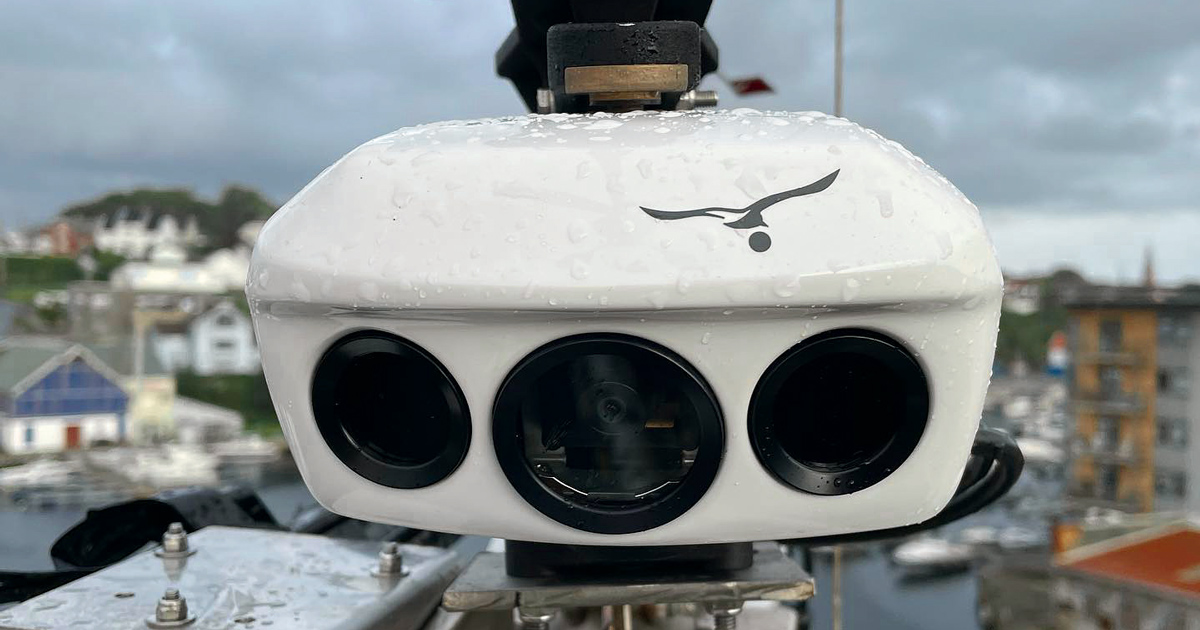
The Competition 320 is a smaller, more affordable unit with a 1km range
The result is a six-strong range of products from the entry level One 320, with a single fixed thermal camera and a range of 1km, up to the flagship Sentry, an all-singing, all-dancing set-up with two sets of thermal and low light cameras, 360-degree vision and a detection range of up to 6km.
It’s fully compatible with existing navigation systems using the NMEA 2000 interface as well as both IOS and Android based tablet and smartphones.
It’s not cheap – prices range from €9,999 for the One 320 up to €39,990 for the Sentry plus an annual software licence of €999.
And while it’s a valuable safety tool, you can’t yet legally rely on it to keep watch without human back-up.
However, with self-driving cars already on the way and the potential for OSCAR to link to an autopilot, it can only be a matter of time before it can handle the night shift alone.
First published in the February 2022 issue of MBY.
Galeon 440 Fly sea trial: You won’t believe how much they’ve packed in!
Pardo gt65 first look: 64 footer with expansive foredeck lounge, how to check your chartplotter’s accuracy, latest videos, parker sorrento yacht tour: 50-knot cruiser with a killer aft cabin, yamarin 80 dc tour: a new direction for the nordic day cruiser, is this the best compact cruiser money can buy aquador 250 ht tour.

By SuperyachtNews 26 Dec 2020
AI and yachting
Mike blake, president of palladium technologies, on what the future of artificial intelligence will really look like….

Artificial intelligence (AI), which is the simulation of human intelligence, has become very prominent in the news, discussions and applications over the past five years. But the truth is that AI has been around for much longer, as I started developing AI applications back in 1987.
Today, we are surrounded in our daily lives with AI – in social media, online shopping, Google search engines, ridesharing, commercial flights (autopilots), banking and many more. Since it is difficult for most us to identify these implementations, and since we can’t distinguish between AI and non-AI systems, there are four basic forms of AI and I will explain them as follows:
1. Reactive machines – good examples are IBM’s Deep Blue, which beat the international chess grandmaster Garry Kasparov in the late 1990s.
2. Limited memory – machines that look into the past, such as parts of self-driving car software.
3. Theory of mind – these machines are more advanced and not only form representations of the world, but also entities in the world. It is this replication of how humans and creatures in the world have thoughts and emotions which affect their own behaviour.
4. Self awareness – this is the most advanced form of AI where these machines/systems develop a consciousness. Conscious beings are aware of themselves, know about their internal states and are able to predict feelings of others. The movies iRobot and Terminator are very good examples of this self awareness.
Why is there such excitement surrounding the first few levels of implementation of AI today? It is because we can use these AI systems/algorithms to handle massive amounts of data and learning, then developing patterns in this data, which we humans can’t do as efficiently. They operate without breaks, and they continue to learn at a speed of the computers that they operate on, 24/7. Good examples can be found in the medical field. In radiology, AI has achieved the ability to detect cancer in mammograms at a 96.6 per cent specificity level, which is much greater than the average radiologist today. It continues to learn at breakneck speeds, continually getting better with its discovery of cancer.
Now, how do we translate these systems and examples to our world of yachting?
The examples that I am about to give may frighten, or even anger, some people who might feel that their own professions are at risk. But in reality I believe that this assistance will allow us to be freed up to perform tasks that we are much better at.
This is an easy one as we move into self-learning autopilots, that are connected online with volumes of information about sea conditions, weather patterns, direct reporting from other ships and yachts, along with on-board navigation instrumentation. They can make much better decisions and never become distracted. This is happening today, in the shipping industry, in a limited fashion.
Cybersecurity
The only way to combat dynamically changing data attacks is to deploy sound and sophisticated AI appliances that morph their shields incautiously to protect the integrity of the yacht’s systems, and the owner’s data.
We are using AI routines in our security systems to understand the patterns of the yacht’s operation, identifying intrusions more quickly and immediately identifying the correct access to all areas of the yacht through facial recognition.
Alarm, monitoring and control (AMS) Another area that benefits from the use of AI algorithms. These algorithms move the AMS from a reactionary system to a truly forward-watching and preventive system.
Owner/guest services
By implementing AI to learn the patterns of the owner and guests, these systems can then anticipate their needs. Simply knowing their system vitals such as blood pressure, heart rate, temperature would allow an AI-driven guest services system to react precisely and immediately. I envision that robotics will be deployed in the future to interact directly with the owner and guests. Consistency in this service would be a major benefit, along with the ability to be available at all hours of the day and night to the varying schedules of each individual.
Entertainment systems
These systems, in general, have the label of AV (audio visual). I have a design for a ‘living yacht’, where the yacht reacts dynamically to the individual and/or individuals in an area of the yacht. Using AI learning we can change the environment in the area of the yacht to provide the entertainment experience that is matched directly to the audience, including their current temperament and past histories of likes, which will provide the ultimate user experience.
Approaching AI with the right attitude is very important, and it might be best to consider it as a tool with which to make our lives better and easier. As individuals, we will not stop the implementation of AI in our daily lives. If we embrace it, we can help steer the direction that it is headed so that it benefits us.
Profile links
Palladium Technologies, Inc
Join the discussion
To post comments please Sign in or Register
When commenting please follow our house rules
Click here to become part of The Superyacht Group community, and join us in our mission to make this industry accessible to all, and prosperous for the long-term. We are offering access to the superyacht industry’s most comprehensive and longstanding archive of business-critical information, as well as a comprehensive, real-time superyacht fleet database, for just £10 per month, because we are One Industry with One Mission. Sign up here .
Related news
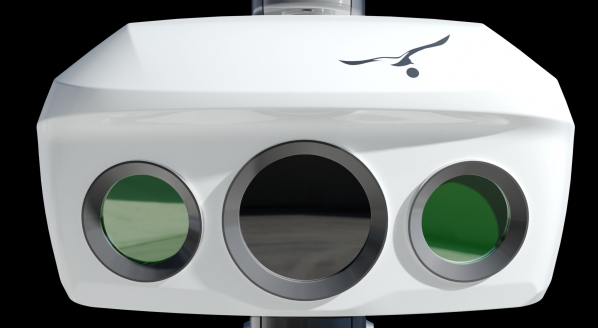
Collision avoidance by artificial intelligence
OSCAR uses thermal and colour cameras and artificial intelligence to prevent collisions with objects at sea

Integrating artificial intelligence on board
The integration of new technology will keep systems up to date with the needs of the crew using them
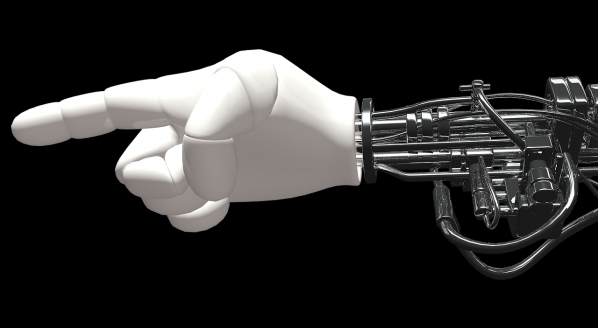
Keeping pace with technology
With technology evolving so quickly, we urgently need to rethink how we design, build and interact with our superyachts
4 years ago
7 years ago
Sign up to the SuperyachtNews Bulletin
Receive unrivalled market intelligence, weekly headlines and the most relevant and insightful journalism directly to your inbox.
Sign up to the SuperyachtNews Bulletin
The superyachtnews app.

Follow us on
Media Pack Request
Please select exactly what you would like to receive from us by ticking the boxes below:
SuperyachtNews.com
Register to comment
WE’RE HIRING DESIGNERS, NAVAL ARCHITECTS, AND PROJECT MANAGERS! CLICK HERE TO ENQUIRE DIRECTLY WITH OUR LEADERSHIP >

DLBA YACHTING NEWS
A superyacht optimized with artificial intelligence in every system.
MARCH 24, 2020
With the rapid advancement of artificial intelligence (AI), the potential for impressive and boundary-pushing progress across all aspects in yachting is at our fingertips. Advancements in automation of vessel machinery, electrical, and navigation systems has an immense potential to improve the yachting experience for all owners. With the immense potential for revolution comes the need for extensive design, engineering, and testing. DLBA Naval Architects is developing a 58m concept superyacht, which thinks through all vessel systems to see where artificial intelligence can take the superyacht experience to the next level. Within DLBA Naval Architects’ Virginia offices, a concept is underway which could change the trajectory of yachting.

DLBA has selected a 58m superyacht concept to develop internally as an autonomous yacht. The result, TEMPO, will be a study in all vessel systems where artificial intelligence can be used to enhance an owner’s experience onboard. The name of the concept is tied to the uptick in operational tempo that the AI will make possible through enhanced reliability and operational availability, meaning that owners and guest will be able to spend more quality time onboard enjoying all that yachting can offer.
There are three main areas where autonomous technology can be brought to bear in the maritime world – navigational autonomy, equipment health monitoring, and mechanical and electrical systems automation. DLBA’s vision is to deliver best-in-class autonomous vessels as the industry-leading vessel designer and autonomy integrator, and it’s expected that, through this process, questions which are already being raised on autonomy will be answered to move this field forward.
Taken alone, any of the three branches of navigation autonomy, equipment health monitoring, and mechanical and electrical system automation can have a profound effect on the operation of a yacht; when designed into the vessel from its conception, that effect can be groundbreaking with respect to maximizing availability and minimizing operational and maintenance costs.
The company’s prior experience with autonomous vessel research and development programs means it’s well-placed to understand the challenges and limitations of this field and has seen it partner with traditional and non-traditional technology providers to push automation for the best
This allows the company agility as it integrates continually-evolving autonomous technology into the concept yacht, the exterior design of which was provided by SDG; and it’s looking forward to working with visionary vessel owners seeking to benefit from autonomy themselves.
Navigation Autonomy
Navigation autonomy relieves the workload on the vessel operator, and unmanned vessels have been operating in the commercial and military space for years. Autonomous navigation systems create an electronic world model, fusing data from onboard sensors, and information sources like GPS, radar, AIS, electronic charts, weather information systems and video cameras to safely navigate both highly-congested areas and open seas.
The operator is left to maintain a presence while the autonomous navigation system guides the vessel. The reduced level of focus required in this area results in higher situational awareness. The benefits to this include a reduced risk of collision and grounding, avoidance of heavy weather, optimization of fuel consumption and lower operator workload.

Mechanical and Electrical System Automation
Mechanical and electrical system automation is like having an onboard engineering team at your fingertips. By ensuring elements at the sub-system level are AI-ready, the vessel can be kept operating at peak performance, without any additional workload for the onboard engineering team. Think changes of valve orientation, turning on and off electrical equipment breakers, starting and stopping pumps, or addressing system faults when they occur; all carried out automatically based on the single push of a button. The result is less work for the engineering team and greater reliability of the vessel; and that means more hours of use for the owner.
Capturing and monitoring the data in real time provides advanced diagnostics and prognostics of onboard systems and equipment through the use of sensors and data collection. Trending and machine learning can then be used to provide real time feedback onboard the vessel for almost all systems, which can then be used to identify almost all potential faults in advance – allowing for correction before they occur and maximizing the owner’s use and enjoyment of the vessel.

Cybersecurity
Considering the risks associated with advanced electronic communication and control systems, the vessel is being develop with integrated cybersecurity. Communication channels and mission critical information needs to be encrypted and protected against both malicious and unintentional adverse impact of misconfiguration and data compromises. Hardware and software for autonomy is assessed for vulnerabilities and hardened against potential intrusion attempts.
Unmanned and autonomous solution’s dependence on accurate and timely communication makes cyber resiliency in an autonomous solution a prime security objective. Convergence of information and operational technology, including ICS components, on autonomous vessels highlight the importance of data integrity and system availability. A comprehensive and a holistic cybersecurity approach addresses these concerns.
Share this article online:
How can we help you, feel free to contact us.

DLBA has selected a 58m superyacht concept to develop internally as an autonomous yacht. The result, Tempo, will be a study in all vessel systems where artificial intelligence can be used to enhance an owner’s experience onboard. The name of the concept is tied to the uptick in operational tempo that the AI will make possible through enhanced reliability and operational availability, meaning that owners and guest will be able to spend more quality time onboard enjoying all that yachting can offer.
There are three main areas where autonomous technology can be brought to bear in the maritime world – navigational autonomy, equipment health monitoring, and mechanical and electrical systems automation. DLBA’s vision is to deliver best-in-class autonomous vessels as the industry-leading vessel designer and autonomy integrator, and it’s expected that, through this process, questions which are already being raised on autonomy will be answered to move this field forward.

Taken alone, any of the three branches of navigation autonomy, equipment health monitoring, and mechanical and electrical system automation can have a profound effect on the operation of a yacht; when designed into the vessel from its conception, that effect can be groundbreaking with respect to maximizing availability and minimizing operational and maintenance costs.
The company’s prior experience with autonomous vessel research and development programs means it’s well-placed to understand the challenges and limitations of this field and has seen it partner with traditional and non-traditional technology providers to push automation for the best results.
This allows the company agility as it integrates continually-evolving autonomous technology into the concept yacht, the exterior design of which was provided by SDG; and it’s looking forward to working with visionary vessel owners seeking to benefit from autonomy themselves.
Navigation Autonomy Navigation autonomy relieves the workload on the vessel operator, and unmanned vessels have been operating in the commercial and military space for years. Autonomous navigation systems create an electronic world model, fusing data from onboard sensors, and information sources like GPS, radar, AIS, electronic charts, weather information systems and video cameras to safely navigate both highly-congested areas and open seas.
The operator is left to maintain a presence while the autonomous navigation system guides the vessel. The reduced level of focus required in this area results in higher situational awareness. The benefits to this include a reduced risk of collision and grounding, avoidance of heavy weather, optimization of fuel consumption and lower operator workload.
Mechanical and Electrical System Automation Mechanical and electrical system automation is like having an onboard engineering team at your fingertips. By ensuring elements at the sub-system level are AI-ready, the vessel can be kept operating at peak performance, without any additional workload for the onboard engineering team. Think changes of valve orientation, turning on and off electrical equipment breakers, starting and stopping pumps, or addressing system faults when they occur; all carried out automatically based on the single push of a button. The result is less work for the engineering team and greater reliability of the vessel; and that means more hours of use for the owner.
Equipment Health Monitoring The number and complexity of auxiliary systems and equipment onboard yachts is increasing year-on-year, and with that comes the increasing demand on crews’ time to interpret feedback from the systems. When the yacht is operational and all systems are active, the sheer volume to be monitored can become overwhelming, which is where computing power can be harnessed to streamline the process and provide a better outcome for vessel owners.
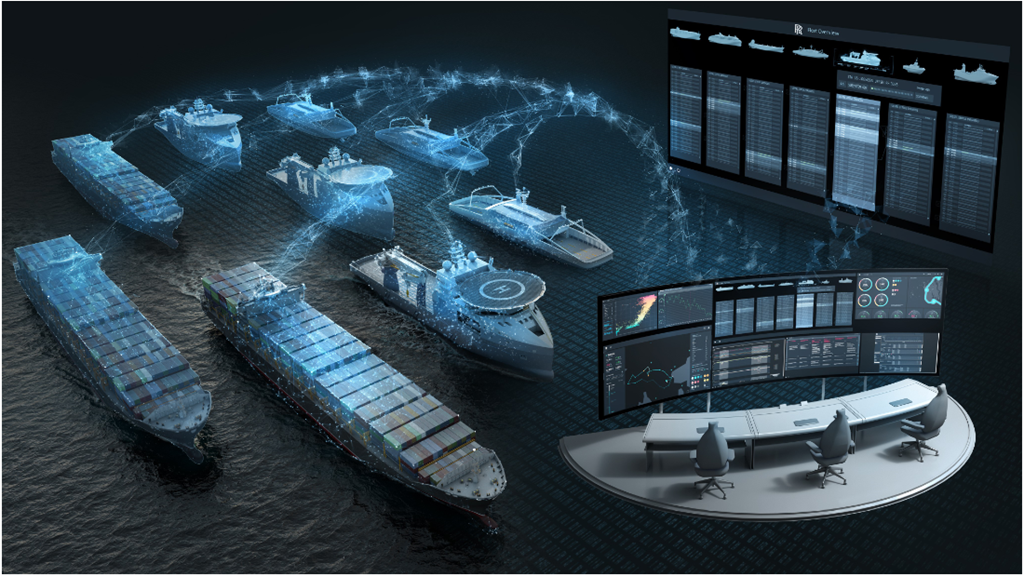
Capturing and monitoring the data in real time provides advanced diagnostics and prognostics of onboard systems and equipment through the use of sensors and data collection. Trending and machine learning can then be used to provide real time feedback onboard the vessel for almost all systems, which can then be used to identify almost all potential faults in advance – allowing for correction before they occur and maximizing the owner’s use and enjoyment of the vessel.
Cybersecurity Considering the risks associated with advanced electronic communication and control systems, the vessel is being develop with integrated cybersecurity. Communication channels and mission critical information needs to be encrypted and protected against both malicious and unintentional adverse impact of misconfiguration and data compromises. Hardware and software for autonomy is assessed for vulnerabilities and hardened against potential intrusion attempts.

Unmanned and autonomous solution’s dependence on accurate and timely communication makes cyber resiliency in an autonomous solution a prime security objective. Convergence of information and operational technology, including ICS components, on autonomous vessels highlight the importance of data integrity and system availability. A comprehensive and a holistic cybersecurity approach addresses these concerns.

RELATED ARTICLES
The toroidal propeller: the pinwheel innovation for marine engines, torqeedo takes on hydrogen fuel cells for emission-free boating, world’s most famous superyacht now operating a bio-sea ballast water treatment system, cmc marine partners with benetti yachtmaster 2022.
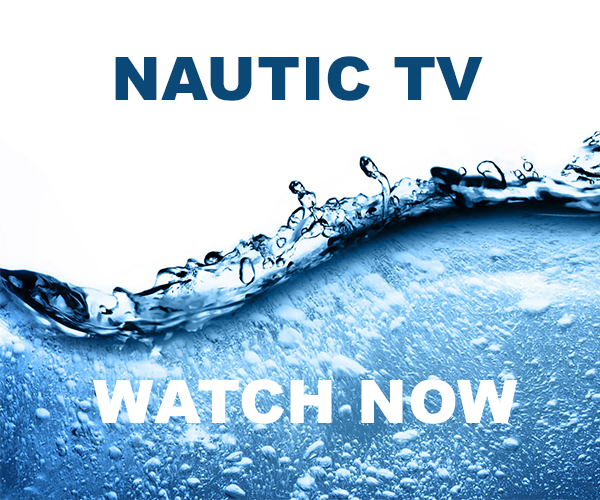
Subscribe to our newsletter
To be updated with all the latest news, offers and special announcements.
LATEST ARTICLES
The luna rossa prada pirelli power team, hetairos wins the round antigua race, éric péron finishes fifth and completes the circle in the arkéa ultim challenge – brest, intensive training session for emirates team new zealand in perfect conditions, editor picks, canadian beau lake introduces the tahoe ’14 and lugano ’14 electric runabouts, underwater adventure and exploration with deepflight’s super falcon 3s, driving performance on land and on water: 41′ amg carbon edition, popular posts, young designer of the year 2022: ioana valentina corcodel reveals 65m ophelia concept, mirabaud sailing video of the century: celebrating 2 decades of passion, superyacht the flying fox seized in the dominican republic, popular category.
- Regatta 803
- America's Cup 377
- Motor Yachts 260
- Boating 215
- Superyachts 181
- Sailing 176
- Yachts News 173
- Sailing Yachts 161

Online Cyber-Crimes and Aggression Case Study Among Adolescents in Canada
Construction investment increase buoyed by positivity in financial sector for 3q.
Alarming Experiences of Canadians with Long-term Symptoms from COVID-19
Canada-EU Summit: Creating good, middle-class jobs, and building a strong, secure future with European partners
How Does Your Quality of Life, Virtual Health Care and Trust Compare in 2023
These 4 Steps Will Empower You To Be a More Prepared and Confident Investor This Year
How did the canadian economy and the consumer price index correlate in 2023, consumer price index edges higher to close out 2023, income inequality still persistent in canadian society since covid-19.
Gross Domestic Product, Income and Expenditure Economic Activity Report – 3Q
FIBA World Cup: Canada defeats USA in OT 127 – 118 to win Bronze Medal
Djokovic Gets Revenge and 24th Grand Slam by Beating Medvedev in US Open
FIBA World Cup: Canada defeats Luca Doncic and Slovenia 100 – 89 to Advance to Semis
FIBA World Cup: Canada concludes Dominant Group Play with 101 – 75 Victory vs Latvia
Canada Continues Dominant Display in Victory over Lebanon 128 – 73 at FIBA World Cup
Cat Nutrition and The Best Grain Free Food With 0 Preservatives
Food Affordability among Canadian families in an Exasperated Inflationary Economy
Has 5 years of the Controversial Cannabis Legalization Been Beneficial to Canadians
A Path to Words: A Comprehensive Guide for Teaching Your 3-Year-Olds to Read
Baby Advice for New Parents to Have a Healthy Lifestyle
Selfcare Through Skin Care : Discover The Magic Skincare Products for 2024
10 Effective Tips To Improve Digestion For Thanksgiving
Why Taking Supplements Is Absolutely Beneficial
Happy New Year from Allymonews
Motion Picture Business Still Profitable Amid Strike
Taylor Swift changes Course – New Eras Tour Coming to Toronto
Hollywood Actors Joining Writers with Strike at Midnight
Art Basel 2023 Edition in Basel, Switzerland is June 15 -18f
Is Donald Trump Going to Jail? The Controversial President Saga Intensifies
Climate Governance new mandate from Canada Climate Law Initiative to help mining execs
Glamour on Your Wrist: Exploring the Top 5 Fascinating Watch Brands Worldwide
Could the Artificial Intelligence Phenomenon also Revolutionize the Yachting Industry
The Ultimate Review of Louis Vuitton Bags
Art Sales Around the World approach $68 Billion, Signalling Subdued Growth
Have the Three Governments Replied to the Asylum Crisis in Toronto
Alberta gets allocated $53 million from federal gov’t to combat anti-gun and gang work
Canada’s Debt-to-GDP Ratio Sparks Debate over Trudeau Government’s Budget Deficit and Spending Priorities, including Tax Credits and Disability Tax Credit
Strengthening Canada’s Financial System Against Money Laundering and Terrorism Financing
How Circular Supply Chains are Revolutionizing Electronics Manufacturing
Traffic Congestion Can Be Alleviated by Electric Bicycles
6 Ways Cannabis Helps In Building Immunity
Robotaxis are getting closer than you think
How Kenya’s Nzambi Matee is Recycling Plastic for Bricks
Investment in Building Construction Activity, July 2023 – Not Encouraging
Construction Industry Continues Astounding 4th Straight Month of Decline
Healthcare Workers Quitting Jobs cite Absurd Workloads as #1 Reason
Robotic Glove Provides Hope after Stroke for Piano Players
Apple introduces Astounding iPhone 15 and iPhone 15 Plus
Silicon Will Revolutionize Batteries in the Smartphone Market
Could the Increase in Advanced Technology Adoption lead to Unemployment or Job Creation
Artificial Intelligence (AI) is undeniably becoming more prominent in our everyday lives. Its development has now reached the superyacht industry, with IYC being the first company to introduce AI to yacht management.
Table of Contents

Artificial Intelligence and Yachts
Whether you fear it or are for it, there is no denying the fact that Artificial Intelligence (AI) is creating endless possibilities within the world that we live in. This limitless potential extends to the yachting industry, an industry known for its luxurious nature and its place amongst society’s elite. From trip planning to fuel calculations, AI has the potential to completely reshape the industry , moving us into the future of yachting.
The First Yacht Company to Introduce AI
What was once mere speculation has become a reality: IYC is the first company to introduce AI to yacht management. They have created a software named BLUE which seamlessly ties all yacht management operations together, streamlining life onboard. It is a market-leading yacht support software system exclusive to IYC, having already proved popular with owners and crew as it is straight-forward to use, increases efficiency and ensures compliance.

Anna is BLUE’s AI Yacht Manager; she handles administrative tasks and compliance requirements whilst guiding crew, owners and managers. She operates as a ‘virtual yacht manager’ ensuring increased safety on board.
Celine Robins, the Global Yacht Management Director of IYC, has commented on the significance of BLUE: ‘ This is the first time in the world that artificial intelligence is brought into the yachting industry and to yacht management. That is extremely revolutionary. Artificial intelligence is going to reshape our world.’
In a recent announcement, Robins proceeded to provide insights into the significance of BLUE not only for the industry, but for IYC and for clients. She recognised the reduction of costs as well as no more human errors, both benefits for IYC. She believes that more focused work due to the simplicity of the software will result in increased consumer satisfaction, ensuring repeat clients for the vessels.

The Benefits of Artificial Intelligence
The benefits for the owner are also cost-related; the preventative maintenance provided by BLUE will save the owner a lot of money as yacht checks and services will be carried out regularly and on time.
The future is undeniably bright with BLUE; as the software grows and AI becomes more prominent in our everyday lives , there is limitless potential and endless possibilities for virtual solutions.
Related Articles
Leave a reply cancel reply.
Save my name, email, and website in this browser for the next time I comment.
ALLYmonews is your news, entertainment, music fashion website. We provide you with the latest breaking news and videos straight from the entertainment industry. Fashion fades, only style remains the same. Fashion never stops. There are always projects, opportunities. Clothes mean nothing until someone lives in them.
Contact us: [email protected]
Subscribe to our Newsletter
- With Regards to Allymonews
- Advertise With Us
© 2023 ALLYmonews.ca || All Rights Reserved
- Cover Letters
- Jobs I've Applied To
- Saved Searches
- Subscriptions
Marine Corps
Coast guard.
- Space Force
- Military Podcasts
- Benefits Home
- Military Pay and Money
- Veteran Health Care
- VA eBenefits
- Veteran Job Search
- Military Skills Translator
- Upload Your Resume
- Veteran Employment Project
- Vet Friendly Employers
- Career Advice
- Military Life Home
- Military Trivia Game
- Veterans Day
- Spouse & Family
- Military History
- Discounts Home
- Featured Discounts
- Veterans Day Restaurant Discounts
- Electronics
- Join the Military Home
- Contact a Recruiter
- Military Fitness
- Vincent Astor, Yachting Spy

Vincent Astor's yacht, the Nourmahal, was among the largest private boats on the seas. Partly financed by the more than $300,000 profits realized from his investment in the 1926 film version of Ben-Hur: A Tale of the Christ, the 263-foot ship was over-the-top in both luxury and technology for its time. It was built by the Krupp Iron Works, which would later turn out U-boats, in Kiel, Germany,
Astor occasionally used the Nourmahal (Persian for “light of the palace”—or, more playfully, “harem’) to host monthly meetings of “The Room,” a small, tightly knit group of powerful, well-connected men —no women—who met in secret to share intelligence garnered from New York’s social whirl, travel, and business dealings. With 11 state rooms and a crew of more than 40, the “Nourmy,” as Astor’s guests called it, also sometimes hosted his friend, patron and, beginning in 1933, President of the United States, Franklin D. Roosevelt.
Not all the cruises were social, however. In 1938 Astor and Kermit Roosevelt, Theodore Roosevelt’s son, undertook a reconnaissance mission under cover of scientific expedition to surveil Japan’s military activity on the Marshall Islands. Outfitted with a radio on loan from the U.S. Navy, they were to report on things like docks, fuel depots, and airstrips.
Astor seemed nearly giddy on the eve of his spy mission.
“I don’t want to make you jealous, but aren’t you a bit envious of my trip?” he wrote the president. “My deportment in the Marshalls will be perfect,” he went on. “When and if, however, there is something that deserves taking a chance—or if I notice increasing suspicion or resentment, I would like to be able to send a ‘standby’ message to Samoa or Hawaii.” The emergency signal would be the word, “automobile.”
The mission, not altogether successful, did yield some intelligence, according to ONI historian Jeffery M. Dorwart . Although unable to get close enough to the targets for visual accounts, Astor intercepted radio signals from Eniwetok Atoll confirming it as a principal Japanese naval base and Bikini a secondary.
Conversations with British officials supplemented his reports. It would be among the last of the long voyagers for Astor on the Nourmahal. Like his previous yacht, the Noma, the ship would see service in the war effort, commissioned into the fleet of the U.S. Coast Guard in 1940, then the U.S. Navy in 1942.
When the State Department got wind of Astor’s back channel arrangement, the flow of intelligence was temporarily halted. It resumed with the 1940 arrival of William Stephenson (famously known as Intrepid) , head of the British Security Coordination (BSC), and his American-born wife, Mary. Astor personally invited Stephenson to lodge at the St. Regis, the luxurious and technically advanced hotel—telephones in every room and an early version of air conditioning— founded in 1904 by his father, John Jacob Astor IV , one of the richest men of his time, who had died in the 1912 sinking of the Titanic. The invitation, puckishly derided the luxury hotel as a “broken down boarding house.”
Despite the anodyne name, the British Security Coordination would eventually grow into one of the largest and wide-ranging clandestine intelligence operations of the war. With FDR’s secret approval, the BSC was going to help nudge Americans into supporting Britain’s desperate defiance of the Nazis. Stephenson’s aggressively vague remit allowed him to launch operations that ranged from traditional intelligence-gathering via secretly recruited agents to highly creative black propaganda efforts. Among the BSC operations Stephenson oversaw were honey traps, safe-cracking in embassies, planting stories in the press, and even a high-profile publicity tour by an astrologer who predicted American victory in the war.
On February 4, 1941, Stephenson wired back to London, “President has appointed Vincent Astor as his personal liaison with me…This arrangement is a great step forward and should considerably facilitate our efforts…”
It was through Astor that London gained a reliable and secure source to contact the president directly regarding matters that could not properly be transmitted through formal diplomatic channels.
Among the items Stephenson transmitted through Astor was a top secret report on Vichy French activities in the U.S., obtained by bugging the New York office of Jean Louis Musa, a naturalized American who supervised the activities of the Vichy Gestapo. This was not a new approach by British intelligence. During WWI, a British banker-spy in Manhattan, Sir William Wiseman, had established a very similar line of communication with President Wilson via trusted presidential adviser Col. Edward House.
The gentlemanly espionage of The Room, however, with Astor comfortably operating among his well-heeled peers, was coming to an end, along with the free-wheeling days of the gentleman spy answerable only to the president. With America’s entry into the war following the Japanese attack on Pearl Harbor, the men of The Room were scattered among government agencies and wartime industries. William Donovan went on to head up the OSS, while David K.E. Bruce oversaw the European branch of the OSS in London. Allen Dulles, a future head of the CIA, would also enter the service under Donovan’s OSS in Switzerland.
Manhattan Transfer
In April 1941, Astor was appointed “Area Controller for the New York Area.” The specified responsibilities were “coordination” of “intelligence and investigational activities in the New York area undertaken by representatives of the Departments of State, Navy, War and Justice.” Astor, who held the Navy Reserve rank of commander, was authorized to “act as a clearing house for problems” and incoming intelligence in New York. Whether he was auditioning for a top spot in America’s nascent intelligence effort is not known, though he was soon beset by rivals and discovered himself unsuited to the rough and tumble politics of inter-agency bureaucratic combat.
At a time when control over intelligence operations seemed up for grabs, there was no shortage of competitors among both seasoned professionals like J. Edgar Hoover and Donovan, as well as ambitious amateurs, such as the newspaper columnist and author John Franklin Carter, who ran a boutique spy agency for the president.
“Carter may be the only writer who first created a fictional intelligence agency and then persuaded a government to put him in charge of a real organization modeled on it,” according to Steve Usdin, author of Bureau of Spies: The Secret Connections Between Journalism and Espionage in Washington, writing in the CIA’s in-house journal, Studies in Intelligence .
Bureaucratic hassles were also not in short supply. For instance, OSS chief Donovan found himself in direct conflict with Hoover and the FBI as well as some truly unexpected adversaries. At one point, Ruth Shipley, ensconced in the Passport Division of the Department of State, refused to provide passports to Donovan’s under cover officers without stamping them “OSS,” thereby giving away the game. It took FDR’s presidential intervention to force Shipley, likely a Hoover loyalist, to finally relent.
In another instance, Donovan fended off the Washington, D.C. police department and Interior Secretary Harold Ickes when an OSS courier was pulled over for zooming across the Arlington Memorial Bridge at the breakneck speed of 50 mph to deliver film to a waiting plane. Ickes deemed the speeding “reprehensible.” Unlike Astor, Donovan seemed to relish the fight. “I have greater enemies in Washington than Hitller in Europe,” he quipped to his assistant Fisher Howe.
Things were no better at ONI for Astor. Although he tackled the assignment with enthusiasm, internal correspondence wrote him and his position off as a “make work” project for a friend of the president. “Astor must have a job…,” one internal memo read. “Vincent Astor, for your information, stands very close to the great white father, so proceed with caution.” This attitude, though somewhat inaccurate, is understandable given that Astor reported directly to FDR. But what today would be called “compartmented” activity worked against Astor’s in-house reputation. The secret nature of his clandestine activities made it appear as if he had done very little, when, in fact, he had been quite busy.
One operation in particular seemed to cause him consternation. An overseas network run by a shady character offended Astor’s fiduciary sensibility with its seemingly unlimited budget, but almost as offensive was the spymaster running the operation. He was, in Astor’s opinion, not only indiscreet, but also a “social climber.” Espionage has always involved the cash-and-carry cooperation of less than gentlemanly characters, but what comes across in a letter delivered by messenger to FDR, was genuine shock at the ungentlemanly nature of the individual involved.
Someone also leaked Astor’s role as FDR’s private spy, diminishing his effectiveness in the role. A confidential report on Astor requested by the president did nothing to help his cause. Increasingly marginalized, Astor focused on coordinating civilian boats, such as fishing trawlers, to patrol the eastern seaboard and establish defenses against U-Boats along the East Coast. Ill health eventually curtailed his duties, and in 1944 he officially resigned the post.
By then, Donovan had long been established in the top spot of the OSS. Hoover was somewhat appeased with suzerainty over domestic efforts against spies and saboteurs and a slice of the foreign espionage pie in South America.
If Astor’s wartime duty as a spy was minimal, he remained significant by providing an infrastructure in which both British and American spies could operate throughout the conflict. As something akin to a quartermaster, not only did he loan out the Nourmy to the war effort, his properties were freely made available to Anglo-American intelligence efforts as needed. The St. Regis became something of a spy hub, too, so impressing the young Naval intelligence officer Ian Fleming during a May 1941 stay with his superior, Admiral John Henry Godfrey, that he wrote the hotel into a Bond adventure. In Live and Let Die (1954) Fleming describes the St. Regis as “the best hotel in New York,” and Bond meets his CIA contact, Felix Leiter, in the hotel’s King Cole Bar. Double-0-7 would later stay at the Astor Hotel, another family property, in Diamonds are Forever (1956).
It was also in a St. Regis suite that Stephenson persuaded Wall Street lawyer and World War I hero Donovan to undertake a fact-finding trip to besieged England. Donovan, whose organization of the fledgling OSS is said to have been influenced in part by suggestions passed along by Godfrey and Fleming, later presented James Bond’s creator with a .38 Police Positive revolver inscribed “For Special Services.”
And, for a brief period of time, the OSS was run out of the St. Regis. In early April of 1942, after suffering a car crash in Washington, Donovan had himself carried aboard a train to New York to attend a scheduled meeting at the swanky hotel. Deposited in a two-room suite, he soon learned that not only was his leg broken, but a blood clot had traveled to his lung causing a dangerous embolism. For the next six weeks the spy chief remained ensconced in the suite, receiving official visits, dictating letters and memorandum and talking on the phone. “I’m still in the ring,” he reported to friends.
In addition to the St. Regis, Astor made other properties available for intelligence work. At a Times Square property, he provided space for a company calling itself Diesel Research. An FBI front company headed by double agent John Sebold, Diesel’s sixth-floor office space included a hidden compartment from which FBI agents filmed activities of what the Abwehr believed was their own clandestine communications operation. For nearly two years, the German-born Sebold, a naturalized American citizen, posed as an operative in a German spy ring led by a South African-born Nazi agent, Joubert “Fritz” Duquesne.
Sebold and Diesel Research would prove one of the FBI’s most successful operations. In 1941 the Bureau rolled up the Duquesne Spy Ring, leading to 33 convictions of Abwehr operatives. The case inspired an Academy Award-winning 1945 Hollywood film, The House on 92nd Street , featuring cameos by multiple FBI special agents as well as Hoover himself.
Astor had also bought a floundering magazine known as News-week (soon to become Newsweek) and allowed both British SIS officers and the FBI to use the magazine as cover for overseas assignments.
Patrician Tact
As with many citizen spies who served America’s intelligence efforts, Astor did not pursue or receive public recognition or private payment for his clandestine efforts. Although some writers mischaracterize his espionage activity as a rich man’s folly, both public and private documents indicate he took the work seriously and made significant contributions. However, the war’s end signaled the emergence of a new conflict—the Cold War—and new, more professional, intelligence organizations required to counter the threat.
According to credible accounts, Astor turned gloomy in his later years. His third marriage, this one to Brooke Russell, a former long time mistress whom he had once pursued with love letters, gifts of expensive jewelry, and introductions to glamorous acquaintances, had turned sour.
With his health increasingly failing, Astor began drinking more heavily, became something of a recluse, and curtailed his wife’s once active social life. Reports of Astor, particularly during his last years, remain somewhat contradictory, depending on what side of the inheritance the observer eventually landed on.
The presence of the enormous fortune that burdened him early on continued to prove a central fact of his life. He is said to have taken up the hobby of re-writing his will, sending repeated shockwaves through the family. There was, according to reports, much speculation over who would get what, and how much. An adult case of mumps had, reportedly, precluded heirs.
But for anyone who had paid close attention to his life , there need not have been much of a mystery. When Astor died in 1959 of a heart attack in his Manhattan apartment on East End Avenue at age 67, he left more than enough to provide for his widow. The bulk of his estate, however—estimated at $40 million—went to the Vincent Astor Foundation, “dedicated to the alleviation of human misery.”
Newspapers around the world noted his death, though even the most elaborate obituaries made scant mention of his espionage efforts. As to be expected, all of them invariably made much of the enormous fortune he left behind. As a spy, he remained largely a ghost. ###
New SpyTalk contributor Henry R. Schlesinger is an author and journalist who has been writing about things espionage for more than two decades. His most recent book is Honey Trapped: Sex, Betrayal, and Weaponized Love .
This article first appeared on Spytalk.co .
You May Also Like
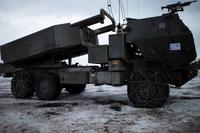
For more than two decades, the High Mobility Artillery Rocket System, or HIMARS, has served as a key piece for U.S...

Battle lines have been drawn over the plan to build an turf field on the historic Zabriskie-Schedler property in Ridgewood...

"My family shouldn't be the ones who feel like they are in a combat zone."

A Pentagon watchdog review of the military's COVID-19 vaccine exemption process found that each of the branches largely...
Military News
- Investigations and Features
- Military Opinion
Select Service
- National Guard
Most Popular Military News

Col. Seth "S.W." MacCutcheon, the commander of the School of Infantry-West, and Maj. Nicholas Engle, the commander of the...

The series of blasts in the Tierra Caliente — an area along the border of Jalisco and Michoacán states — mark an alarming...

The commanding officer of the USS Ohio sub's gold crew -- Capt. Kurt Balagna -- was relieved by Rear Adm. Nicholas Tilbrook...

Officials at the 222-year-old military academy 60 miles north of New York City recently reworked the one-sentence mission...

Top U.S. officials in the Washington area have received preferential treatment from a little-known health care program run by...
Latest Benefits Info
- How Veterans Can Get Free Online Tutoring
- The Medal of Honor
- Learn All About the 2020 Tricare Open Season at Upcoming Online Event
- Paying for School with Federal Aid
- GI Bill Housing Allowances May Change Soon
More Military Headlines

The United States circulated the final draft of a United Nations Security Council resolution that would support international...

U.N.-backed human rights experts said they have gathered new evidence of “horrific” torture of Ukrainian prisoners of war by...
- Pentagon Complied with COVID-19 Waiver Rules According to Watchdog But Services Moved Slowly
- Duty, Honor, Outrage: Change to West Point's Mission Statement Sparks Controversy
- Soldiers Said Goodbye to Loved Ones as Army Ships Set Sail to Gaza to Build Pier for Aid Delivery
- Air Force Veteran David Harris, the First Black Pilot Hired by a Major US Airline, Has Died at 89
- Air Force Missile Base Personnel Have Elevated Breast, Prostate Cancer Rates, Initial Study Results Indicate
- Navy Fires Commander of USS Ohio -- 3rd Submarine Skipper Relieved in 7 Months
- Sailors Will Now Get 24/7 Access to All Base Gyms Under Navy's New Policy
Military Benefits Updates
- Other Than Honorable Discharge: Everything You Need to Know
- Honorable Discharge: Everything You Need to Know
- PACT Act: Agent Orange Toxic Exposure
- Marine Corps Continues Path to Retirement for Artillery System that Has Seen Heavy Use in Ukraine
- Two Commanders in Marine Corps' West Coast Infantry School Fired on Same Day
- Marine Corps Sends Special Response Unit to Haiti After Partial US Embassy Evacuation
- Coast Guard Navigates Bureaucracy in Fight Against Illegal Fishing
- FBI Looking into 'Debris' Found Off Alaska's Coast
- His Shoes Went Viral. Now, the Coast Guard Member Is Back with New Designs
Entertainment
- The 11 Finalists for the First-Ever American Battlefield Trust Book Prize for History
- Survival Game Pacific Drive Steers You into an Eerie, Hostile Pacific Northwest
- Rapper Shaggy Got His Distinctive Voice from Making Fun of His Marine Corps Drill Instructors

The global authority in superyachting
- NEWSLETTERS
- Yachts Home
- The Superyacht Directory
- Yacht Reports
- Brokerage News
- The largest yachts in the world
- The Register
- Yacht Advice
- Yacht Design
- 12m to 24m yachts
- Monaco Yacht Show
- Builder Directory
- Designer Directory
- Interior Design Directory
- Naval Architect Directory
- Yachts for sale home
- Motor yachts
- Sailing yachts
- Explorer yachts
- Classic yachts
- Sale Broker Directory
- Charter Home
- Yachts for Charter
- Charter Destinations
- Charter Broker Directory
- Destinations Home
- Mediterranean
- South Pacific
- Rest of the World
- Boat Life Home
- Owners' Experiences
- Interiors Suppliers
- Owners' Club
- Captains' Club
- BOAT Showcase
- Boat Presents
- Events Home
- World Superyacht Awards
- Superyacht Design Festival
- Design and Innovation Awards
- Young Designer of the Year Award
- Artistry and Craft Awards
- Explorer Yachts Summit
- Ocean Talks
- The Ocean Awards
- BOAT Connect
- Between the bays
- Golf Invitational
- Boat Pro Home
- Pricing Plan
- Superyacht Insight
- Product Features
- Premium Content
- Testimonials
- Global Order Book
- Tenders & Equipment

Is AI the future for superyacht design?
What happens when you go from ‘computer aided’ to ‘computer generated’ design? New web-based artificial intelligence software that creates images from text input alone has been catching the attention of creatives around the world but does it have a place in yacht design? Andrew Johansson investigates...
New creative artworks have been appearing online in recent weeks that have been created in a way that is more akin to a science-fiction movie than reality. A handful of developers have been hard at work building artificial intelligence platforms that offer the creative community new opportunities. The two main contenders at the time of writing are Dall-E and MidJouney. These platforms offer a similar service with differing results but the principles remain the same. The web-based programmes create visuals by entering a simple sentence into a search bar before returning four images in a matter of seconds. While the results can vary significantly, some can be truly extraordinary.
“It forces you to verbalise your design ideas in an efficient and articulate way. Is it an Art Deco railing or is it an Art Deco railing with ornate flower metal work and a polished brass handrail? In short, you could call it targeted unpredictability,” says designer John Cantu of Cantu Design, the studio behind the in-build 38 metre Garfield, Westport Yachts’ W35 and the refit of 30 metre Redsky .
The American designer has access to both platforms, focusing more on the capabilities of Dall-E — created by OpenAI — and its potential to change the way in which design studios collect inspirational material, create moodboards, explore themes and shapes, and even begin the design process for the exterior or interior spaces of a yacht.
“We’ve been following Dall-E since its early development,” explains Cantu who was granted access to the V2 beta version at the beginning of August 2022. “We have been impressed by how this software thinks and creates art and believe it will be a powerful tool for every creative industry and probably many more. The OpenAI platform can also write articles, movie scripts and so on. What you end up with is a creative content generator that, paired with the right person, can produce incredible results that are unique to your description. There will undoubtedly be sceptics and those who won’t see the value in it but I think the majority of people will view it as an additional source of targeted inspiration.”
Cantu goes on to explain how initially the results he was getting were mixed. However, the more searches were performed, the quicker he began to understand what terms yielded the best results. “We were able to get it to draw a wide range of yachts, from the practical to the most audacious ideas,” says the designer. “It’s interesting how you can focus on the smallest detail or zoom out to a bigger picture.”
Jana Kleine-Kalmer, a freelance interior architect and artist who has worked in collaboration with Cantu Design, agrees. She explains that the devil is in the detail and depending on the description, you can get very targeted results. The more specific the description, the better, with the same being true on MidJourney. However, you also have to understand how the AI software interprets the words and structure of the sentence.
“I was curious to see how Dall-E would react to the complexity of interiors, with the countless different elements that we take for granted in any given environment,” says Kleine-Kalmer. “When we asked for a hotel bedroom, it would focus on the most common denominator of the space, such as a bed or table within a room. It did, however, create very detailed sequences for interior design styles or architectural periods. Results got more creative when we fed it with art history influences or contemporary styles like digital art.”
Dall-E compiles results by pulling information from the web and presents it in a new format. Those with access can use the material created with limited restrictions, as OpenAI stipulates that all images must be credited to their AI but does not assert copyright status over the images so the creator can use them as they see fit. However, as the technology draws on existing content, it is plausible to think that certain creations might potentially come close to an original. It is an aspect that OpenAI appears to be aware of with the inclusion of a complaints procedure for such an eventuality. Dall-E, which at the time of writing, is in the beta stage as the developer continues to refine its artificial general intelligence.
“Designers often make use of web-based content in the process of gathering inspiration as part of a number of sources,” says Cantu. “Whether that be from old French furniture books, walking through a gallery, Pinterest or design magazines, nothing is created in a vacuum. AI art is a unique avenue to this same process."
It is a point that creative director at Thirty C Rob Armstrong agrees with and like Cantu has been exploring the possibilities of Dall-E and MidJourney, focusing on the latter primarily. Working in collaboration with Mahdi Shirzadkhan, director at MS Yacht Design, the duo has had similar experiences. However, one of the main differences between the two platforms is that MidJourney allows the user to instantly refine and further develop the four results it delivers endlessly with a single click. The AI is also being developed with the ability to use your own imagery from which to create new visuals.
“MidJourney sources images from across the web, which it draws upon to build your AI creation but the platform is also changing so you can feed it your own images. I could get it to create something new but based on my work rather than sourcing from other things,” says Armstrong. Thirty C’s portfolio includes the exterior refit of 56 metre Galaxy in collaboration with Njord by Bergman Design House and the soon-to-be-delivered Navier 27. The English designer goes on to reveal the parallel between these AI platforms and a technique he has used for many years to generate new ideas using watercolours on paper.
“I’ll get some really basic lines down and work it up from there,” explains Armstrong. “The paint is doing the AI and you are seeing what’s within it, drawing on your knowledge or imagination to make something from it.” Using this method as an example, you can quickly see how the imagery created by AI platforms could be used and developed into real conceptual projects.
The limits of these platforms seem endless once you understand how to extract the most from them. However, how the market will view it and explore the ways to get the most out of it, will be key.
It comes as no surprise that free but less powerful platforms such as Starry AI, Dream by Wombo and Nightcafe have been released. However, the breadth of possibility and the results that you can achieve varies. With Google also rushing to join the market with their own platform called Imagen, it’ll be interesting to see how the market develops.
However, there are also those for whom this technology is not yet refined enough to be useful or, as co-founder of design studio Nuvolari Lenard, Dan Lenard explains, it is simply not a tool he’d choose to use at this time. “Software with true AI is something we are far from at this point in time,” says Lenard. “It simply cannot express the emotional component in the creative process. Our studio has always got more ideas than opportunities to build them — we have to reduce these to a final and ultimate proposal. We definitely don’t need any more ideas.”
The power of these platforms is extraordinary. Looking at the yacht sector, only time will tell if it will become a beneficial tool. Seeing how these AI platforms might be utilised once officially launched will be exciting to witness.
More stories
Most popular, from our partners, sponsored listings.
- Election 2024
- Entertainment
- Newsletters
- Photography
- Press Releases
- Israel-Hamas War
- Russia-Ukraine War
- Global elections
- Asia Pacific
- Latin America
- Middle East
- AP Top 25 College Football Poll
- Movie reviews
- Book reviews
- Financial Markets
- Business Highlights
- Financial wellness
- Artificial Intelligence
- Social Media
US spearheads first UN resolution on artificial intelligence — aimed at ensuring equal access
FILE - The symbol of the United Nations is displayed on the main gate outside UN headquarters, Feb. 24, 2022, in New York. The United States is spearheading the first United Nations resolution on artificial intelligence, aimed at ensuring the new technology is “safe, secure and trustworthy” and that all countries, especially those in the developing world, have equal access. The draft General Assembly resolution aims to close the digital divide between countries and make sure they are all at the table in discussions on AI. (AP Photo/John Minchillo, file)
- Copy Link copied
UNITED NATIONS (AP) — The United States is spearheading the first United Nations resolution on artificial intelligence , aimed at ensuring the new technology is “safe, secure and trustworthy” and that all countries, especially those in the developing world, have equal access.
The draft General Assembly resolution aims to close the digital divide between countries and make sure they are all at the table in discussions on AI — and that they have the technology and capabilities to take advantage of its benefits, including detecting diseases, predicting floods and training the next generation of workers.
The draft recognizes the rapid acceleration of AI development and use and stresses “the urgency of achieving global consensus on safe, secure and trustworthy artificial intelligence systems.” It also recognizes that “the governance of artificial intelligence systems is an evolving area” that needs further discussions on possible governance approaches.
U.S. National Security Advisor Jake Sullivan said the United States turned to the General Assembly “to have a truly global conversation on how to manage the implications of the fast-advancing technology of AI.”
The resolution “would represent global support for a baseline set of principles for the development and use of AI and would lay out a path to leverage AI systems for good while managing the risks,” he said in a statement to The Associated Press.
If approved, Sullivan said, “this resolution will be an historic step forward in fostering safe, secure and trustworthy AI worldwide.”
The United States began negotiating with the 193 U.N. member nations about three months ago, spent hundreds of hours in direct talks with individual countries, 42 hours in negotiations and accepted input from 120 nations, a senior U.S. official said. The resolution went through several drafts and achieved consensus support from all member states this week and will be formally considered later this month, the official said, speaking on condition of anonymity because he was not authorized to speak publicly.
Unlike Security Council resolutions, General Assembly resolutions are not legally binding but they are an important barometer of world opinion.
A key goal, according to the draft resolution, is to use AI to help spur progress toward achieving the U.N.’s badly lagging development goals for 2030, including ending global hunger and poverty, improving health worldwide, ensuring quality secondary education for all children and achieving gender equality.
The draft resolution encourages all countries, regional and international organizations, technical communities, civil society, the media, academia, research institutions and individuals “to develop and support regulatory and governance approaches and frameworks” for safe AI systems.
It warns against “improper or malicious design, development, deployment and use of artificial intelligence systems, such as without adequate safeguards or in a manner inconsistent with international law.”
Lawmakers in the European Union are set to give final approval to the world’s first comprehensive AI rules on Wednesday. Countries around the world, including the U.S. and China, or global groupings like the Group of 20 industrialized nations also are moving to draw up AI regulations.
The U.S. draft calls on the 193 U.N. member states and others to assist developing countries to access the benefits of digital transformation and safe AI systems. It “emphasizes that human rights and fundamental freedoms must be respected, protected and promoted throughout the life cycle of artificial intelligence systems.”
U.S. Ambassador Linda Thomas-Greenfield recalled President Joe Biden’s address to the General Assembly last year where he said emerging technologies, including AI, hold enormous potential.
She said the resolution, which is co-sponsored by dozens of countries, “aims to build international consensus on a shared approach to the design, development, deployment and use of AI systems,” particularly to support the 2030 U.N. goals.
The resolution responds to “the profound implications of this technology,” Thomas-Greenfield said, and if adopted it will be “an historic step forward in fostering safe, security and trustworthy AI worldwide.”
- Skip to main content
- Keyboard shortcuts for audio player
The world's first comprehensive artificial intelligence legislation is here

Teri Schultz
European Union lawmakers have approved the bloc's "Artificial Intelligence Act."
A MARTÍNEZ, HOST:
The world's first comprehensive AI legislation is here, and it comes from Europe.
LEILA FADEL, HOST:
European Union lawmakers have approved the bloc's Artificial Intelligence Act. It aims to shape the creation of what they call human-centric AI, with regulations which will apply to any product or service that uses the technology.
MARTÍNEZ: Teri Schultz joins us now from Brussels to tell us what the regulations will and will not do.
Teri, governments around the world are trying to figure out how to regulate AI. So what's the European Union doing?
TERI SCHULTZ: Well, this AI act is pretty ambitious, and the EU is quite proud of it. It took several difficult years of negotiation and public feedback. They had to balance this complicated technology and a very powerful industry with consumer protections and then get 27 governments to agree to the same set of rules. Here's one of the parliamentarians who led work on the law, Dragos Tudorache.
(SOUNDBITE OF ARCHIVED RECORDING)
DRAGOS TUDORACHE: We have a duty to recognize this potential because it is going to be the technology that will be driving us into the future. And at the same time, we realize that, clearly, there are risks. There are concerns.
MARTÍNEZ: All right. So that's the philosophical approach to it, Teri. So how are they going to do it practically?
SCHULTZ: So the AI act will classify systems or applications into four categories according to what's considered their potential risk to society - from low to limited to high, up to unacceptable. And each of these will be subject to different levels of regulatory control. At the low end, there won't be any requirements or regulation. And at the unacceptable end, they'll be banned altogether in the EU.
MARTÍNEZ: So OK, give us some examples of what we're talking about here. I mean, who gets to decide how risky a certain use of AI would be?
SCHULTZ: Well, at the low-risk end are applications such as AI in video games or spam filters - we're all familiar with those. And at the unacceptable end are uses such as biometric identification, which will be prohibited in public spaces, except in special cases, like law enforcement or counterterrorism. But authorities will have to get special permission, and it will be really strictly limited. EU governments are the ones responsible for evaluating and enforcing the act on their own territory, but the bloc has set up an office here in Brussels to help coordinate and make sure it's being done in a fair way across the EU. It'll also provide guidance for companies and developers so they're in compliance.
MARTÍNEZ: Ah, developers - that's the other party in this. What's been the response from the tech industry from those developers, and what happens if companies just don't want to comply?
SCHULTZ: Parliamentarians said it was one of the most heavily lobbied pieces of legislation in years, but they feel like they've both protected consumers and the technology's potential. This is how it was described by Brando Benifei, one of the co-leaders of the parliamentary work.
BRANDO BENIFEI: Too many citizens in Europe are skeptical of the use of AI, and I think this is a competitive disadvantage. And this would stifle innovation. Instead, we want our citizens to know that, thanks to our rules, they can trust the businesses that will develop AI in Europe.
SCHULTZ: So A, I'm not sure if tech companies are buying that explanation of how more regulation is going to be good for them, but they won't have a choice. The act will get final approval from EU leaders in the next month or two. It'll be gradually implemented over the next two years, and then violators can be fined up to 7% of a company's annual turnover.
MARTÍNEZ: All right. We'll see how it works out. That's Teri Schultz in Brussels. Teri, thanks.
SCHULTZ: Thanks, A.
Copyright © 2024 NPR. All rights reserved. Visit our website terms of use and permissions pages at www.npr.org for further information.
NPR transcripts are created on a rush deadline by an NPR contractor. This text may not be in its final form and may be updated or revised in the future. Accuracy and availability may vary. The authoritative record of NPR’s programming is the audio record.
Artificial Intelligence Act: MEPs adopt landmark law
Share this page: .
- Safeguards on general purpose artificial intelligence
- Limits on the use of biometric identification systems by law enforcement
- Bans on social scoring and AI used to manipulate or exploit user vulnerabilities
- Right of consumers to launch complaints and receive meaningful explanations

On Wednesday, Parliament approved the Artificial Intelligence Act that ensures safety and compliance with fundamental rights, while boosting innovation.
The regulation, agreed in negotiations with member states in December 2023, was endorsed by MEPs with 523 votes in favour, 46 against and 49 abstentions.
It aims to protect fundamental rights, democracy, the rule of law and environmental sustainability from high-risk AI, while boosting innovation and establishing Europe as a leader in the field. The regulation establishes obligations for AI based on its potential risks and level of impact.
Banned applications
The new rules ban certain AI applications that threaten citizens’ rights, including biometric categorisation systems based on sensitive characteristics and untargeted scraping of facial images from the internet or CCTV footage to create facial recognition databases. Emotion recognition in the workplace and schools, social scoring, predictive policing (when it is based solely on profiling a person or assessing their characteristics), and AI that manipulates human behaviour or exploits people’s vulnerabilities will also be forbidden.
Law enforcement exemptions
The use of biometric identification systems (RBI) by law enforcement is prohibited in principle, except in exhaustively listed and narrowly defined situations. “Real-time” RBI can only be deployed if strict safeguards are met, e.g. its use is limited in time and geographic scope and subject to specific prior judicial or administrative authorisation. Such uses may include, for example, a targeted search of a missing person or preventing a terrorist attack. Using such systems post-facto (“post-remote RBI”) is considered a high-risk use case, requiring judicial authorisation being linked to a criminal offence.
Obligations for high-risk systems
Clear obligations are also foreseen for other high-risk AI systems (due to their significant potential harm to health, safety, fundamental rights, environment, democracy and the rule of law). Examples of high-risk AI uses include critical infrastructure, education and vocational training, employment, essential private and public services (e.g. healthcare, banking), certain systems in law enforcement, migration and border management, justice and democratic processes (e.g. influencing elections). Such systems must assess and reduce risks, maintain use logs, be transparent and accurate, and ensure human oversight. Citizens will have a right to submit complaints about AI systems and receive explanations about decisions based on high-risk AI systems that affect their rights.
Transparency requirements
General-purpose AI (GPAI) systems, and the GPAI models they are based on, must meet certain transparency requirements, including compliance with EU copyright law and publishing detailed summaries of the content used for training. The more powerful GPAI models that could pose systemic risks will face additional requirements, including performing model evaluations, assessing and mitigating systemic risks, and reporting on incidents.
Additionally, artificial or manipulated images, audio or video content (“deepfakes”) need to be clearly labelled as such.
Measures to support innovation and SMEs
Regulatory sandboxes and real-world testing will have to be established at the national level, and made accessible to SMEs and start-ups, to develop and train innovative AI before its placement on the market.
During the plenary debate on Tuesday, the Internal Market Committee co-rapporteur Brando Benifei (S&D, Italy) said: “We finally have the world’s first binding law on artificial intelligence, to reduce risks, create opportunities, combat discrimination, and bring transparency. Thanks to Parliament, unacceptable AI practices will be banned in Europe and the rights of workers and citizens will be protected. The AI Office will now be set up to support companies to start complying with the rules before they enter into force. We ensured that human beings and European values are at the very centre of AI’s development”.
Civil Liberties Committee co-rapporteur Dragos Tudorache (Renew, Romania) said: “The EU has delivered. We have linked the concept of artificial intelligence to the fundamental values that form the basis of our societies. However, much work lies ahead that goes beyond the AI Act itself. AI will push us to rethink the social contract at the heart of our democracies, our education models, labour markets, and the way we conduct warfare. The AI Act is a starting point for a new model of governance built around technology. We must now focus on putting this law into practice”.
The regulation is still subject to a final lawyer-linguist check and is expected to be finally adopted before the end of the legislature (through the so-called corrigendum procedure). The law also needs to be formally endorsed by the Council.
It will enter into force twenty days after its publication in the official Journal, and be fully applicable 24 months after its entry into force, except for: bans on prohibited practises, which will apply six months after the entry into force date; codes of practise (nine months after entry into force); general-purpose AI rules including governance (12 months after entry into force); and obligations for high-risk systems (36 months).
The Artificial Intelligence Act responds directly to citizens’ proposals from the Conference on the Future of Europe (COFE), most concretely to proposal 12(10) on enhancing EU’s competitiveness in strategic sectors, proposal 33(5) on a safe and trustworthy society, including countering disinformation and ensuring humans are ultimately in control, proposal 35 on promoting digital innovation, (3) while ensuring human oversight and (8) trustworthy and responsible use of AI, setting safeguards and ensuring transparency, and proposal 37 (3) on using AI and digital tools to improve citizens’ access to information, including persons with disabilities.
Contacts:
Yasmina yakimova .
- Phone number: (+32) 2 28 42626 (BXL)
- Mobile number: (+32) 470 88 10 60
- E-mail: [email protected]
- Twitter account: @EP_SingleMarket
Janne OJAMO
- Phone number: (+32) 2 284 12 50 (BXL)
- Mobile number: (+32) 470 89 21 92
- E-mail: [email protected]
- Twitter account: @EP_Justice
Further information
- Link to adopted text (13.03.2024)
- Plenary debate (12.03.2024)
- Procedure file
- EP Research Service: compilation of studies on Artificial Intelligence
- Result of roll-call votes (13.03.2024)
- Committee on the Internal Market and Consumer Protection
- Committee on Civil Liberties, Justice and Home Affairs
Product information
Self-docking spacecraft could be built with AI system similar to ChatGPT
There may finally be a way to have spacecraft manage docking procedures autonomously.

Docking one spacecraft with another is a delicate matter. No matter what spacecraft are involved, docking requires a series of extremely precise maneuvers. One slip can result in a major crash and a disastrous mission failure.
Predictably, docking without a human in the pilot’s seat is incredibly tricky. Automatic docking is possible in Earth orbit, but if engineers want to build truly self-driving autonomous spacecraft capable of docking procedures, they’ll need to give them the capacity to actually plan out their own docking maneuvers. Most spacecraft today simply do not have that ability. But some researchers have devised a plan: Delegate the task to an artificial intelligence system quite similar to the one behind ChatGPT.
Related: Machine learning could help track down alien technology. Here's how
Researchers have been trying to make computers perform docking maneuvers since the 1960s, during the very early days of the Space Age. The problem, however, has been that, to properly calculate necessary trajectories for accurate docking, you need a lot of computing power. A spacecraft trying to dock itself away from Earth, or a spacecraft out of reliable contact with ground control, needs to crunch numbers with its own onboard computer — which typically is not a supercomputer.
"For autonomy to work without fail billions of miles away in space, we have to do it in a way that on-board computers can handle," says Simone D’Amico , a professor of aeronautics at Stanford University and one of the researchers, in a statement .
D'Amico and colleagues devised an alternative, artificial intelligence-based method. Their method relies on the Transformer architecture. That's the same type of machine learning that powers ChatGPT and many of its fellow AI chatbots. The researchers call it "Autonomous Rendezvous Transformer," or ART. Instead of dealing with words as ChatGPT does, however, ART crunches spacecraft trajectories.
— In the search for alien life, should we be looking for artificial intelligence?
— ChatGPT on Mars: How AI can help scientists study the Red Planet
— AI just spotted its 1st supernova. Could it replace human explosion hunters?
The goal is for a spacecraft to run ART with its own onboard hardware. It is still early days for ART, but the researchers showed its worth by testing it in computer simulations. Now, they want to test it in a mock space environment. If they can show it works there, then they can take ART into orbit.
The researchers presented their work at the IEEE Aerospace Conference in March 2023, after a preprint was published on arxiv in October 2023.
Join our Space Forums to keep talking space on the latest missions, night sky and more! And if you have a news tip, correction or comment, let us know at: [email protected].
Get the Space.com Newsletter
Breaking space news, the latest updates on rocket launches, skywatching events and more!

Rahul Rao is a graduate of New York University's SHERP and a freelance science writer, regularly covering physics, space, and infrastructure. His work has appeared in Gizmodo, Popular Science, Inverse, IEEE Spectrum, and Continuum. He enjoys riding trains for fun, and he has seen every surviving episode of Doctor Who. He holds a masters degree in science writing from New York University's Science, Health and Environmental Reporting Program (SHERP) and earned a bachelors degree from Vanderbilt University, where he studied English and physics.
SpaceX launches giant Starship rocket into space on epic 3rd test flight (video)
NASA finds clue while solving Voyager 1's communication breakdown case
Watch Jennifer Lopez pilot a space mech in 1st teaser for Netflix sci-fi film 'Atlas' (video)
- Unclear Engineer No, Not ChatGPT. That would totally miss the target point, but still file a progress report that claimed it succeeded and send a bill for its services. If the bill was not paid, it would probably file a lawsuit with a court and include in its complaint a list of non-existing court case references showing that the government always pays for stuff that it does not receive. Reply
- View All 1 Comment
Most Popular
By Robert Lea March 14, 2024
By Brett Tingley March 14, 2024
By Mike Wall March 14, 2024
By Rahul Rao March 14, 2024
By Keith Cooper March 14, 2024
By Jamie Carter March 14, 2024
By Elizabeth Howell March 14, 2024
By Josh Dinner March 14, 2024
- 2 Total solar eclipse 2024: Live updates
- 3 April 8's total solar eclipse will make baseball history. Here's how
- 4 'The New World on Mars' offers a Red Planet settlement guide (exclusive)
- 5 Colliding neutron stars hint at new physics that could explain dark matter

IMAGES
VIDEO
COMMENTS
She operates as a 'virtual yacht manager' ensuring increased safety on board. Celine Robins, the Global Yacht Management Director of IYC, has commented on the significance of BLUE: 'This is the first time in the world that artificial intelligence is brought into the yachting industry and to yacht management. That is extremely revolutionary.
First introduced at BOAT International's Life Under Sail conference in November 2019, OSCAR is a collision-avoidance system of night vision and colour cameras and an artificial-intelligence processor that can tie into a vessel's autopilot (or throttles, too, in a motor yacht). Invented by Raphaël Biancale, it spots floating, stationary or semi-submerged objects, uses AI to assess their ...
Armstrong is one of the many yacht designers and naval architects who have been exploring AI as a tool to aid in the superyacht design process. Other designers have been less keen on embracing AI, warning it could ring the death knell for creativity. Credit: Jordan Nathan Bamforth/Midjourney. The yachting industry's varied opinions on AI are ...
Imagine a fleet of concept yachts straight out of Tolkien's Middle-earth, or a jellyfish-inspired sailing boat with billowing tendril-like sails. In the world of computer-generated yacht design, artificial intelligence (AI) is less blue-sky thinking, more DreamWorks Animation, executed in the blink of an eye.
How AI is Transforming the Superyacht and Business Aviation Industries. For two industries that have much in common, the difference in the adoption of artificial intelligence on private jets versus AI integration on superyachts is stark. While the aviation industry has been using artificial intelligence in its engines for almost 25-30 years now ...
By eliminating a bridge deck, the yacht gains a much sleeker, lower profile with all the knock-on effects that brings to motion and stability without compromising owner lifestyle. ... And like Google glasses, it utilizes sensors and cameras and artificial intelligence that analyze all the data in microseconds for situational analysis. In ...
That's not the only example of the changing role technology is taking in new yacht projects. When it comes to artificial intelligence - about which the philosophical and technological debate is currently raging - in many ways yachts already bear its evolution as sensors on every element of equipment and system start to analyse status and progression to provide predictive maintenance.
Artificial Intelligence (AI) is the ability for technology to gather, synthesise, then act upon information. Machine learning means that this intelligence is refined further, as a computer gets better and better at its task, until it can imitate - or even surpass - human endeavour. Which naturally raises questions.
Bill Edwards, Head of Research and Development at Olesinski, is something of a pioneer when it comes to the use of AI as a tool for yacht design. Edwards utilises artificial intelligence technology (originating from The University of Southampton) to reduce the typical cost and manpower that is required to create a yacht concept. Through the use ...
TEMPO will be a study in all vessel systems where artificial intelligence can be used. The name, TEMPO, is tied to the uptick in operational tempo that the AI will make possible through enhanced reliability and operational availability, meaning that owners and guest will be able to spend more quality time onboard enjoying all that yachting can ...
The Adonis concept yacht is a Numarine 78 with onboard systems that work, in part, based on artificial intelligence. Courtesy Numarine. Founding partners at Furrion, an innovations company based in Indiana, met while working as mega-yacht crew — giving them a hands-on chance to see what technology worked, and what might be improved, out on the water.
Artificial Intelligence will again be in the spotlight on 21/22 March at the 2nd Smart Yacht Rendezvous, organised by Yacht Club de Monaco during Monaco Ocean Week. " We are integrating AI into our daily lives, sometimes without even realising it. Many solutions have already been developed in the yachting sector, tools that I hope will help ...
Unveiled in April 2023, NO STRESS TWO is not your ordinary yacht. With its intelligent hybrid propulsion system, this stunning motor yacht offers five operation modes, dual power systems, and a fast displacement aluminum hull. But what truly sets NO STRESS TWO apart is its integration of Artificial Intelligence, which optimizes electric mode efficiency to provide an unparalleled cruising ...
OSCAR first look: The revolutionary system bringing AI to yacht navigation. A new type of navigation equipment that combines artificial intelligence with both thermal and low light cameras promises to make offshore cruising a safer, more relaxing experience. Aesop's fable about the tortoise and the hare still rings true at sea as owners of ...
Artificial intelligence (AI), which is the simulation of human intelligence, has become very prominent in the news, discussions and applications over the past five years. But the truth is that AI has been around for much longer, as I started developing AI applications back in 1987. ... These systems, in general, have the label of AV (audio ...
DLBA has selected a 58m superyacht concept to develop internally as an autonomous yacht. The result, TEMPO, will be a study in all vessel systems where artificial intelligence can be used to enhance an owner's experience onboard. The name of the concept is tied to the uptick in operational tempo that the AI will make possible through enhanced ...
A superyacht optimized with artificial intelligence in every system. DLBA has selected a 58m superyacht concept to develop internally as an autonomous yacht. The result, Tempo, will be a study in all vessel systems where artificial intelligence can be used to enhance an owner's experience onboard. The name of the concept is tied to the uptick ...
Yet, advances in artificial intelligence and drone technology are opening the door to a solution for this strategic quagmire: make every ship a carrier. A squadron (approximately ten aircraft) of Group 3 or 4 unmanned aerial systems (UAS)—those large enough to fly relatively high, far, and for a long time but are still small enough to fit on ...
Steve Haefele. I 've been thinking about something my boatbuilder pal Mike said as I attempted to shimmy beneath my wife Nelia's high-tech automobile. Mike had been warning me about the dangers of artificial intelligence. "Soon, computers will no longer have any use for humans," he said. "They'll do away with us.".
She operates as a 'virtual yacht manager' ensuring increased safety on board. Celine Robins, the Global Yacht Management Director of IYC, has commented on the significance of BLUE: 'This is the first time in the world that artificial intelligence is brought into the yachting industry and to yacht management. That is extremely revolutionary.
IYC: The First Company In The World To Introduce Artificial Intelligence To Yacht Management. 17th July 2023 IYC's proprietary software BLUE seamlessly ties all our Yacht Management operations together. BLUE was developed in-house to be a market-leading yacht support software, and is 100% exclusive to IYC. Our team's decades of personal ...
The impact of Artificial Intelligence (AI) on Yachting. Artificial Intelligence (AI) is a powerful tool supporting the methods proposed in this article. AI can help stakeholders in the yachting ...
Together with DLBA Naval Architects, we find out what artificial intelligence means for the superyachts of the future. See more. New Designs What superintelligent yachting could mean for your next new build. Written by Parisa Hashempour. 25 Nov 2020 | 15:00. DLBA Naval Architects. DLBA Naval Architects
Published March 14, 2024 at 10:36am ET. Vincent Astor's yacht, the Nourmahal, was among the largest private boats on the seas. Partly financed by the more than $300,000 profits realized from his ...
Dall-E, which at the time of writing, is in the beta stage as the developer continues to refine its artificial general intelligence. Credit: Cantu Design x DALL-E "Designers often make use of web-based content in the process of gathering inspiration as part of a number of sources," says Cantu.
FILE - The symbol of the United Nations is displayed on the main gate outside UN headquarters, Feb. 24, 2022, in New York. The United States is spearheading the first United Nations resolution on artificial intelligence, aimed at ensuring the new technology is "safe, secure and trustworthy" and that all countries, especially those in the developing world, have equal access.
European Union lawmakers have approved the bloc's Artificial Intelligence Act. It aims to shape the creation of what they call human-centric AI, with regulations which will apply to any product or ...
On Wednesday, Parliament approved the Artificial Intelligence Act that ensures safety and compliance with fundamental rights, while boosting innovation. The regulation, agreed in negotiations with member states in December 2023, was endorsed by MEPs with 523 votes in favour, 46 against and 49 abstentions. It aims to protect fundamental rights ...
Launches & Spacecraft. Self-docking spacecraft could be built with AI system similar to ChatGPT. News. By Rahul Rao. published 14 March 2024. There may finally be a way to have spacecraft manage ...
The European Parliament approved on Wednesday a landmark political agreement on artificial intelligence. The world's first major set of regulatory rules to govern artificial intelligence, the AI ...